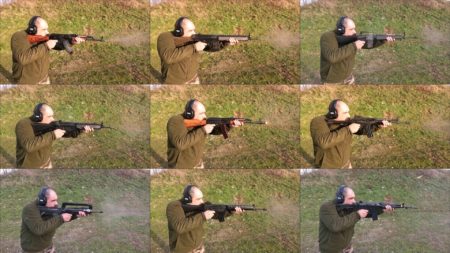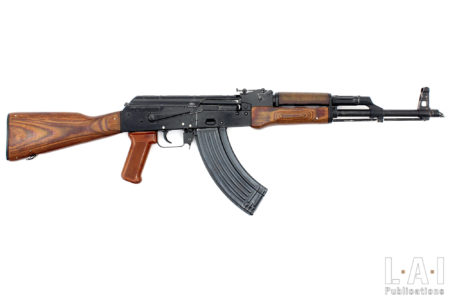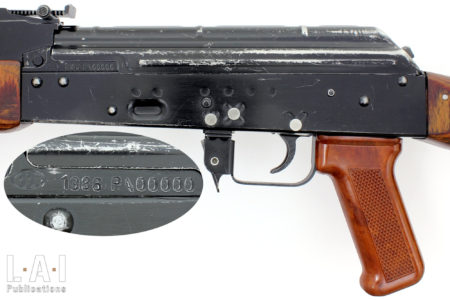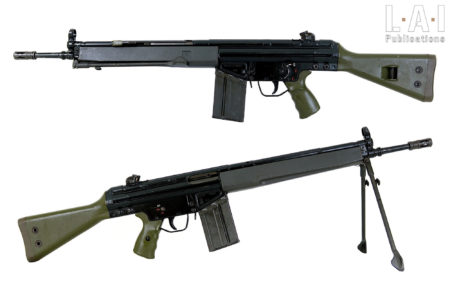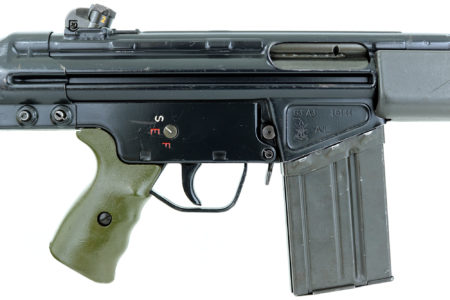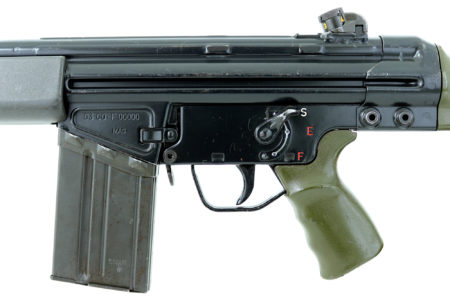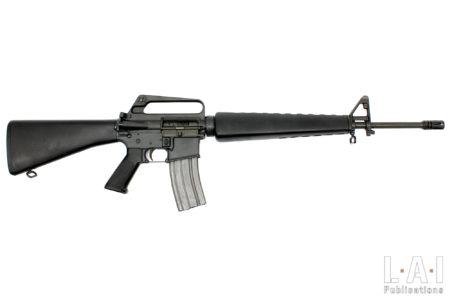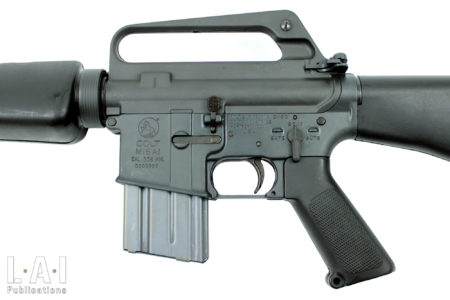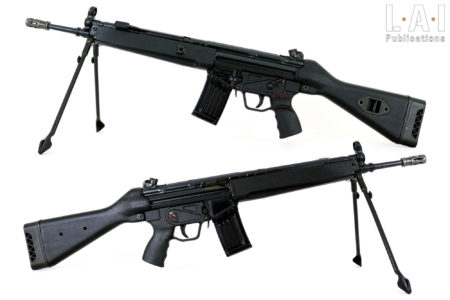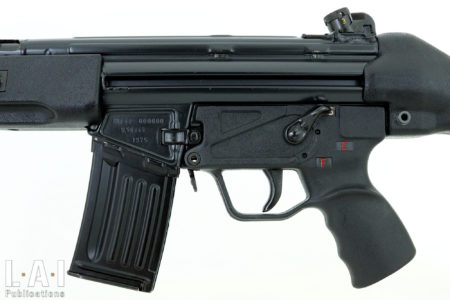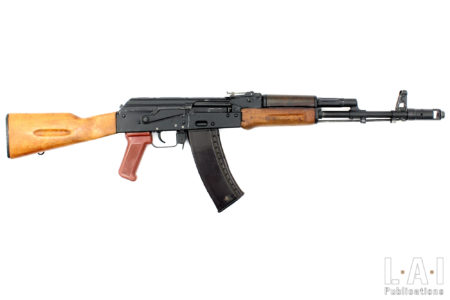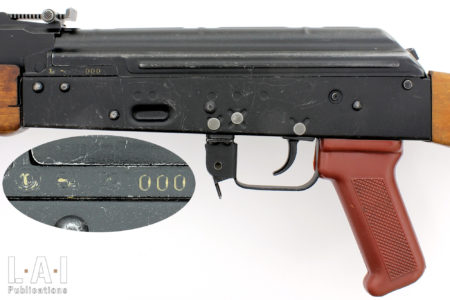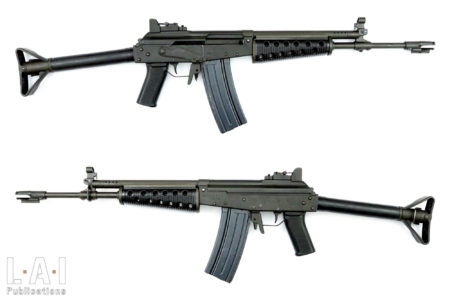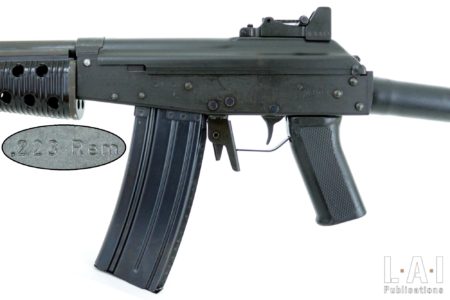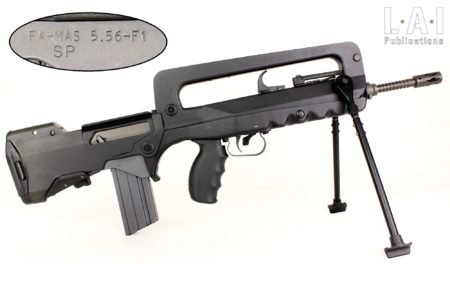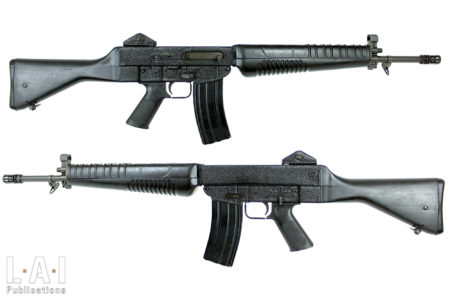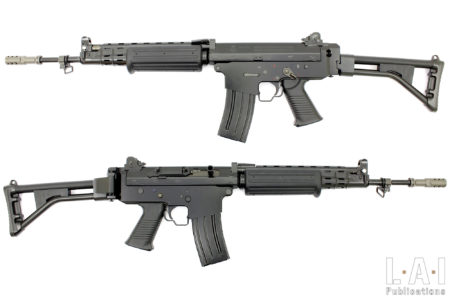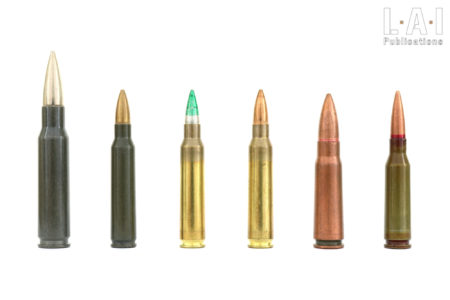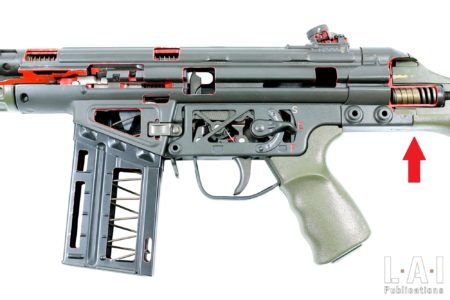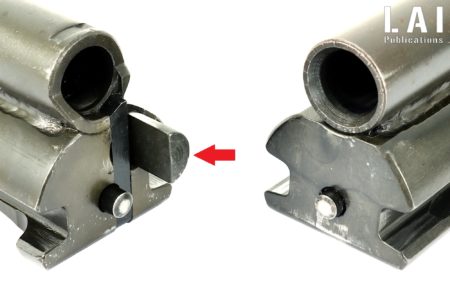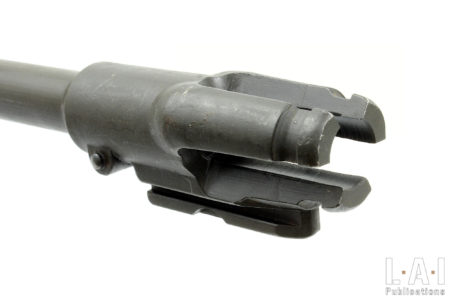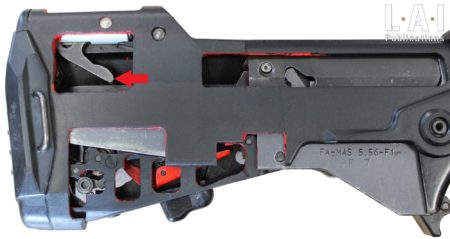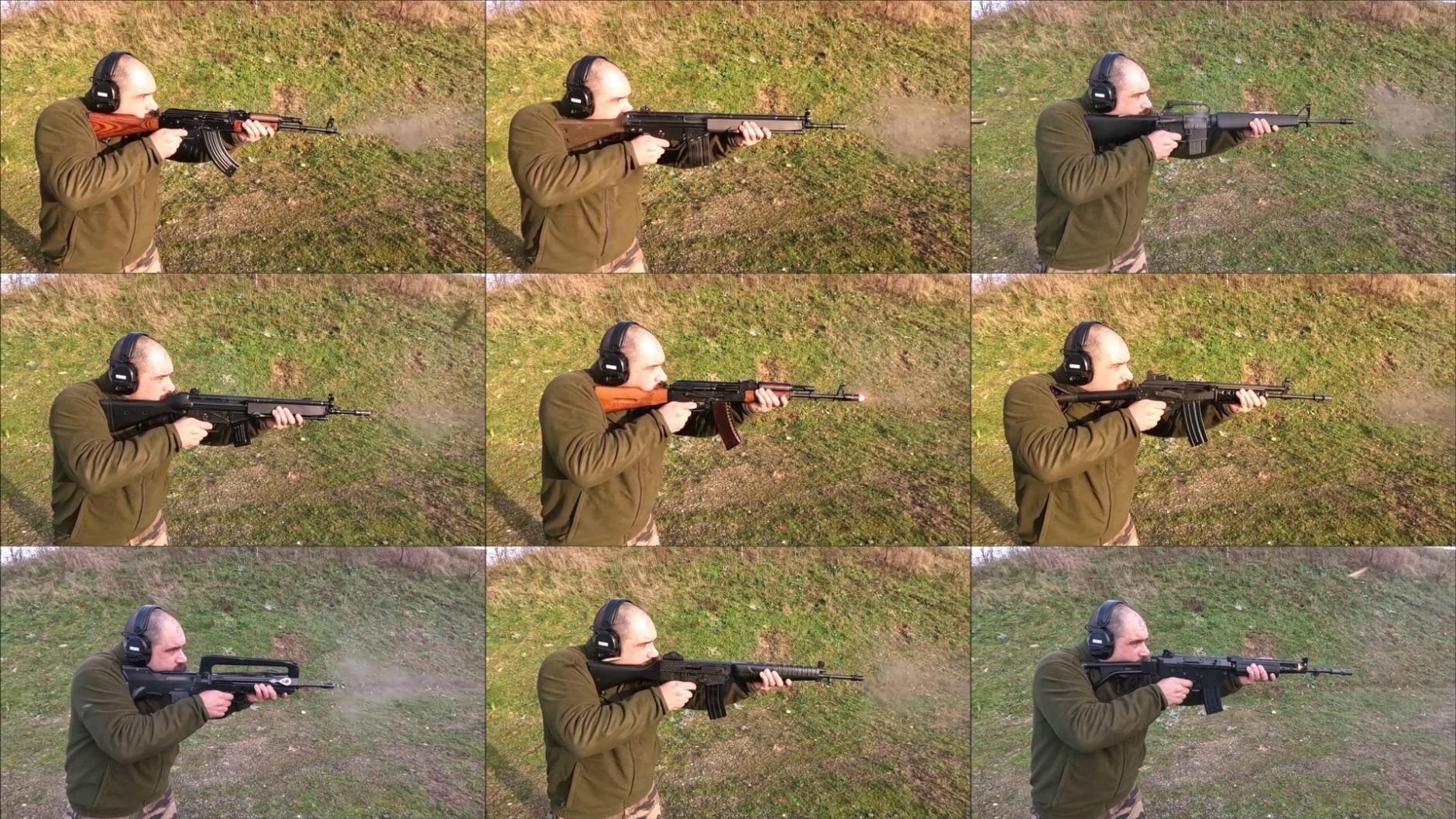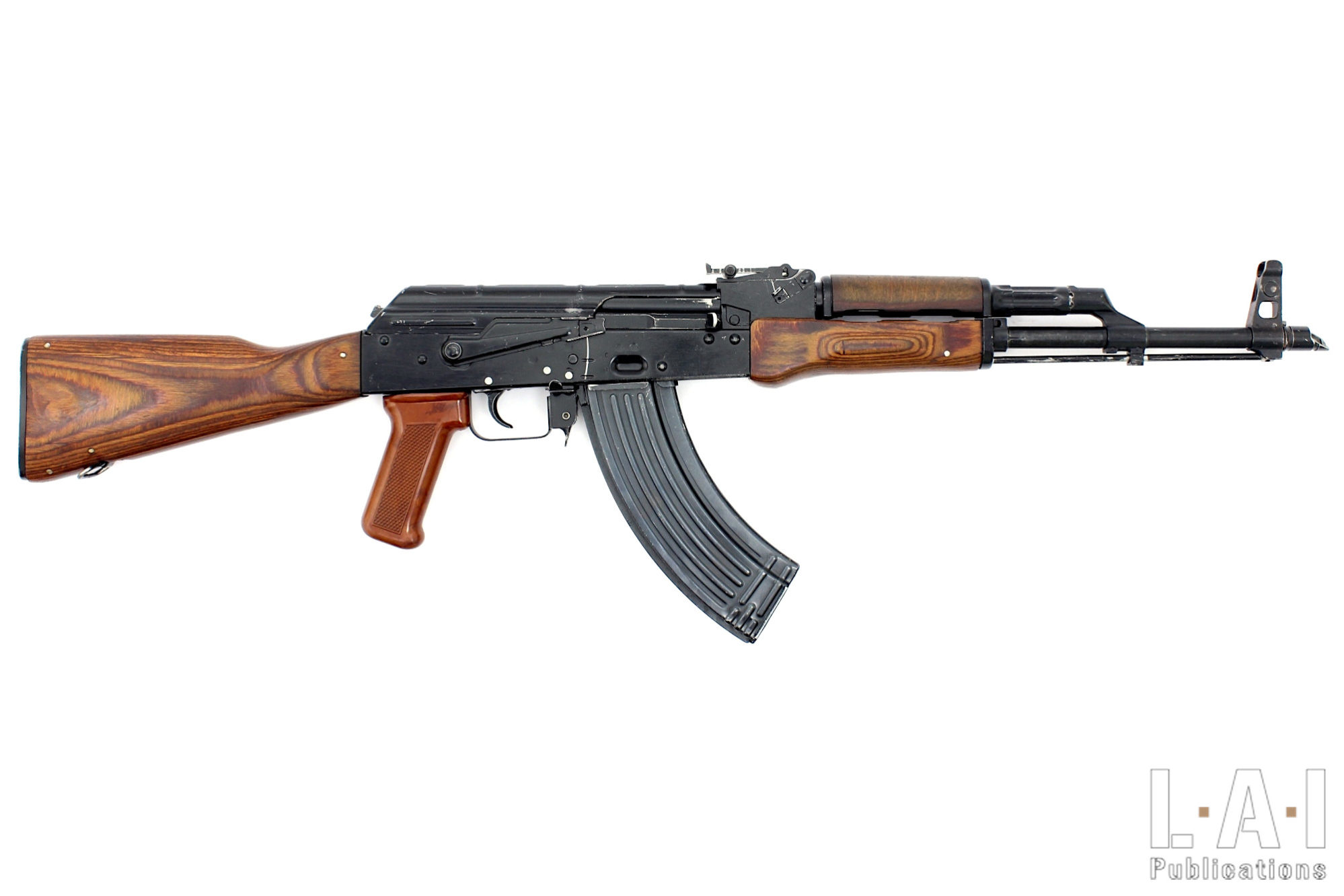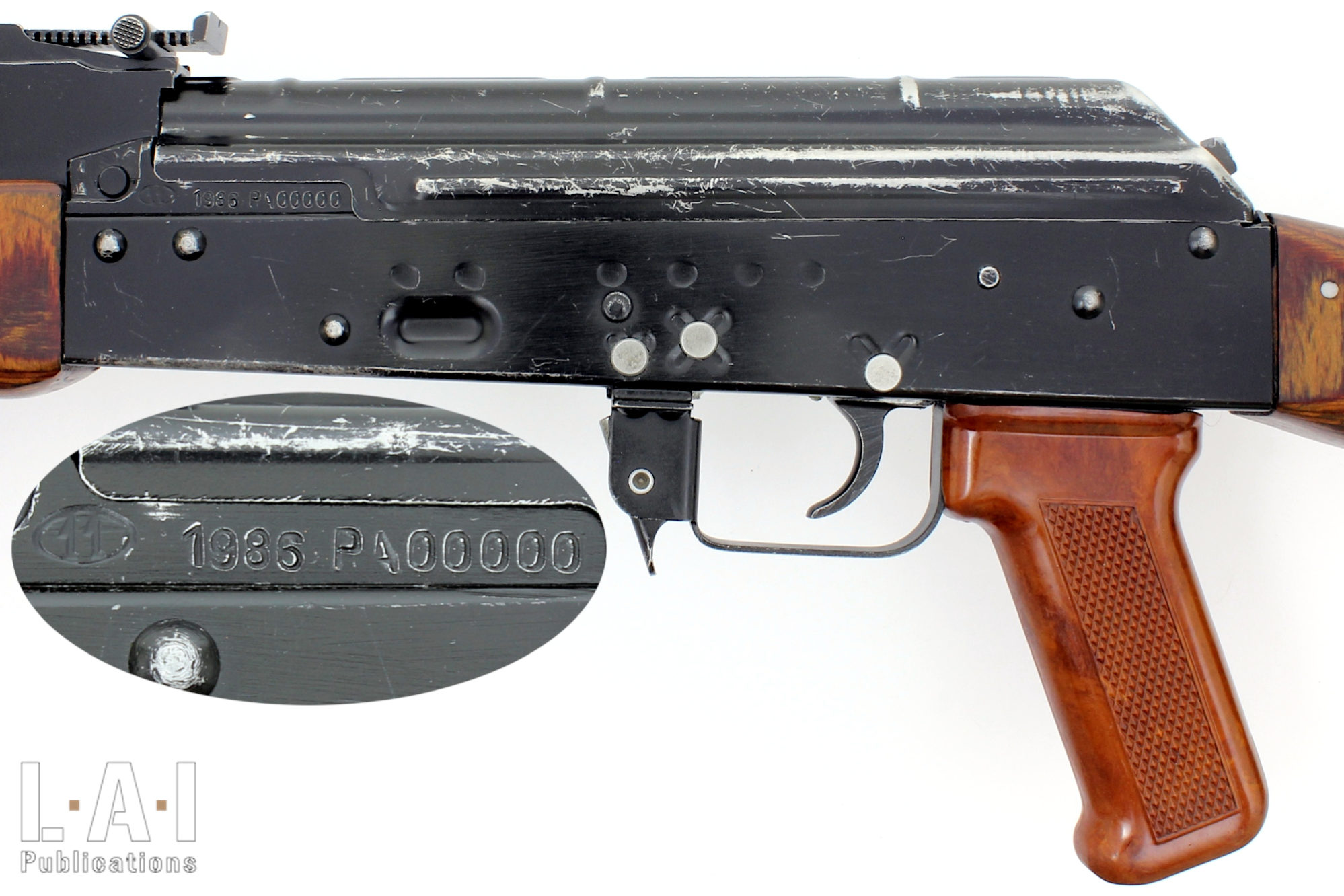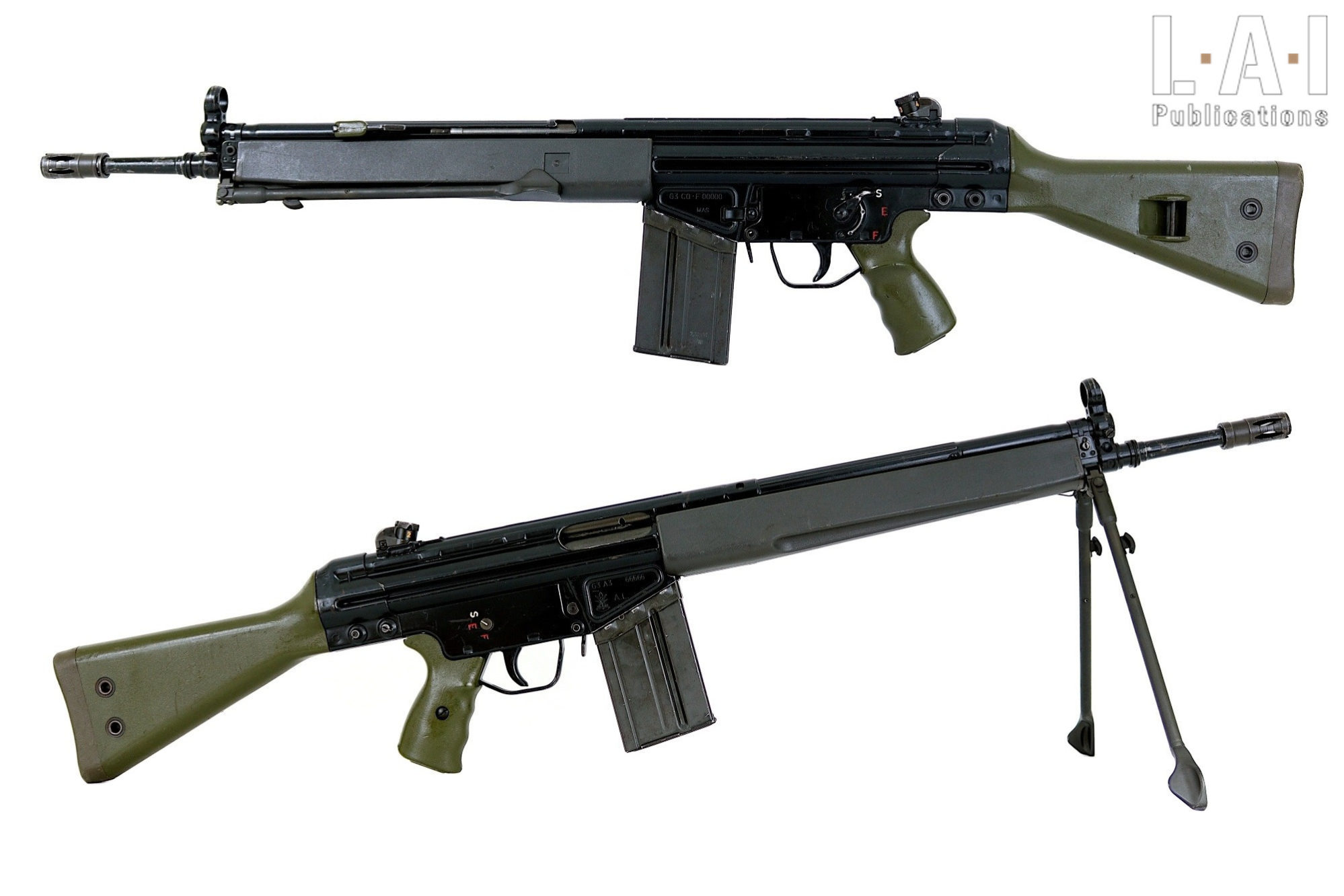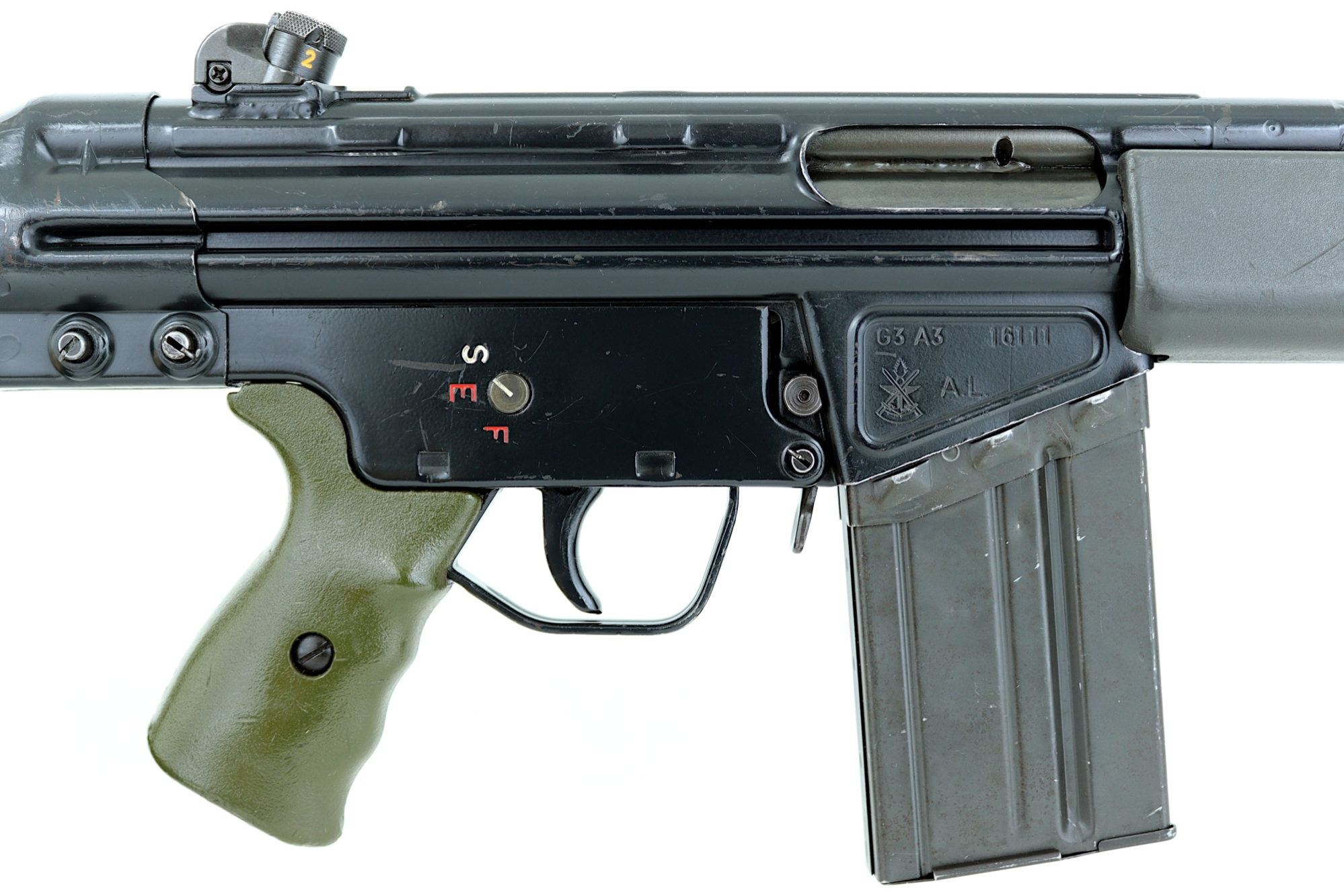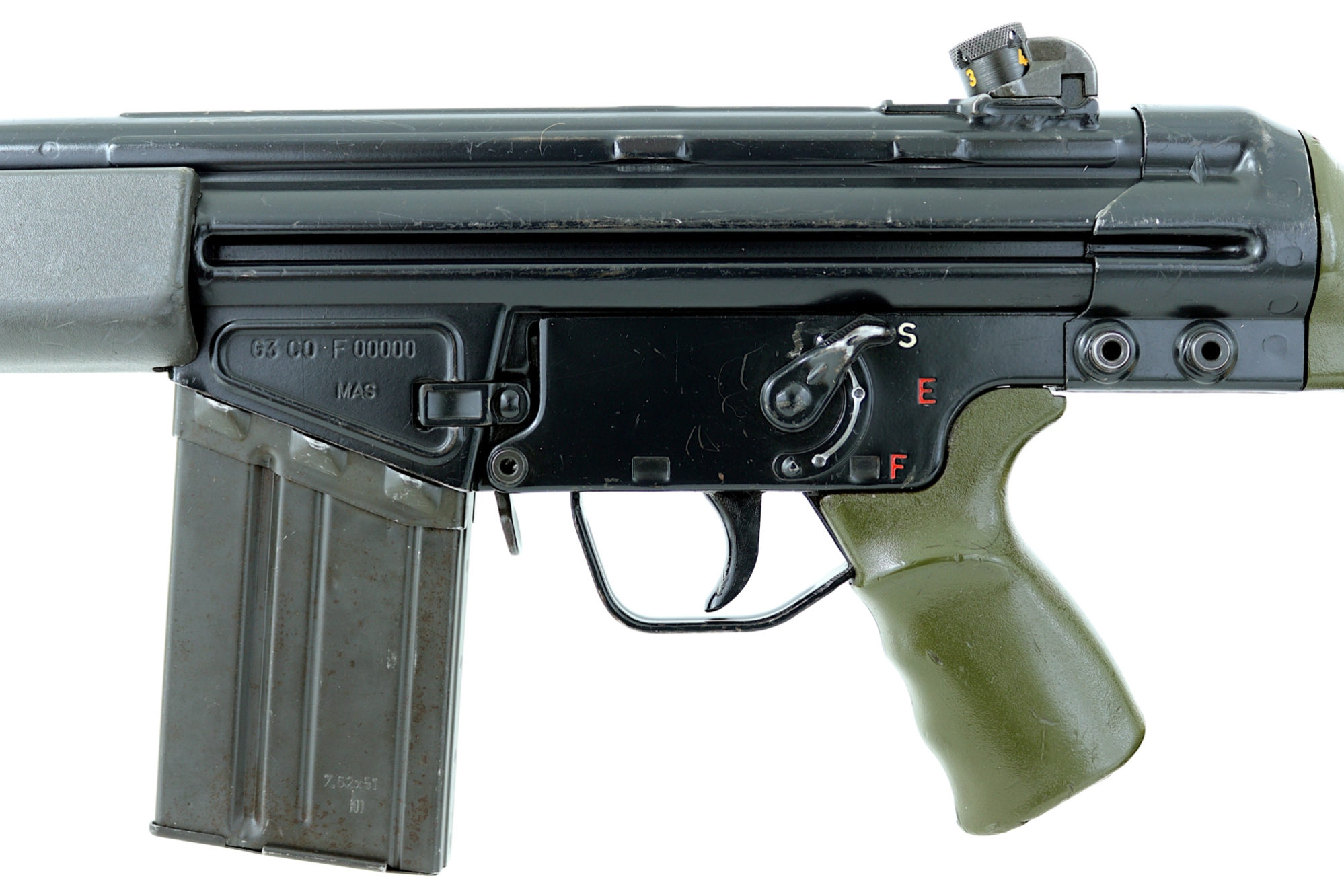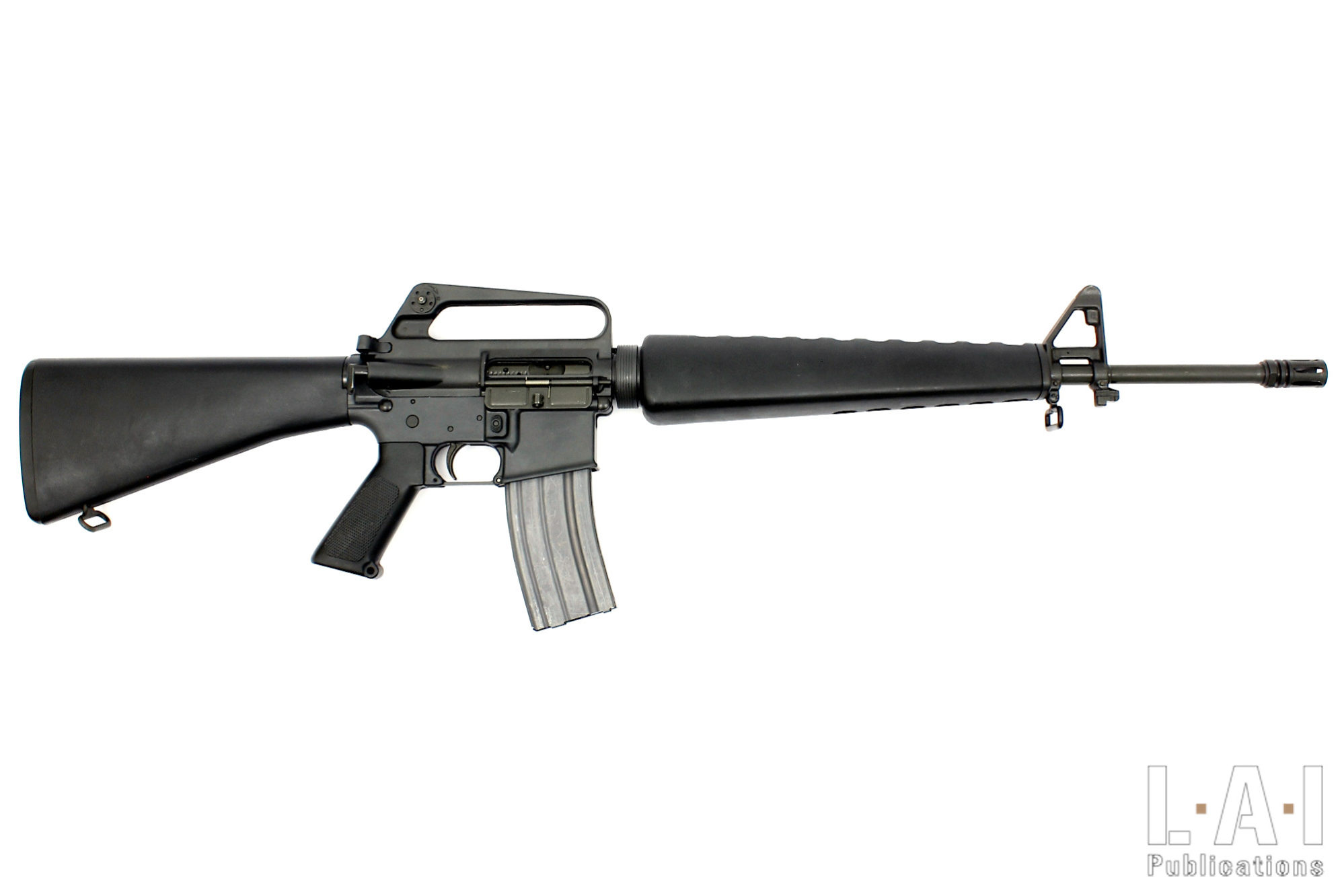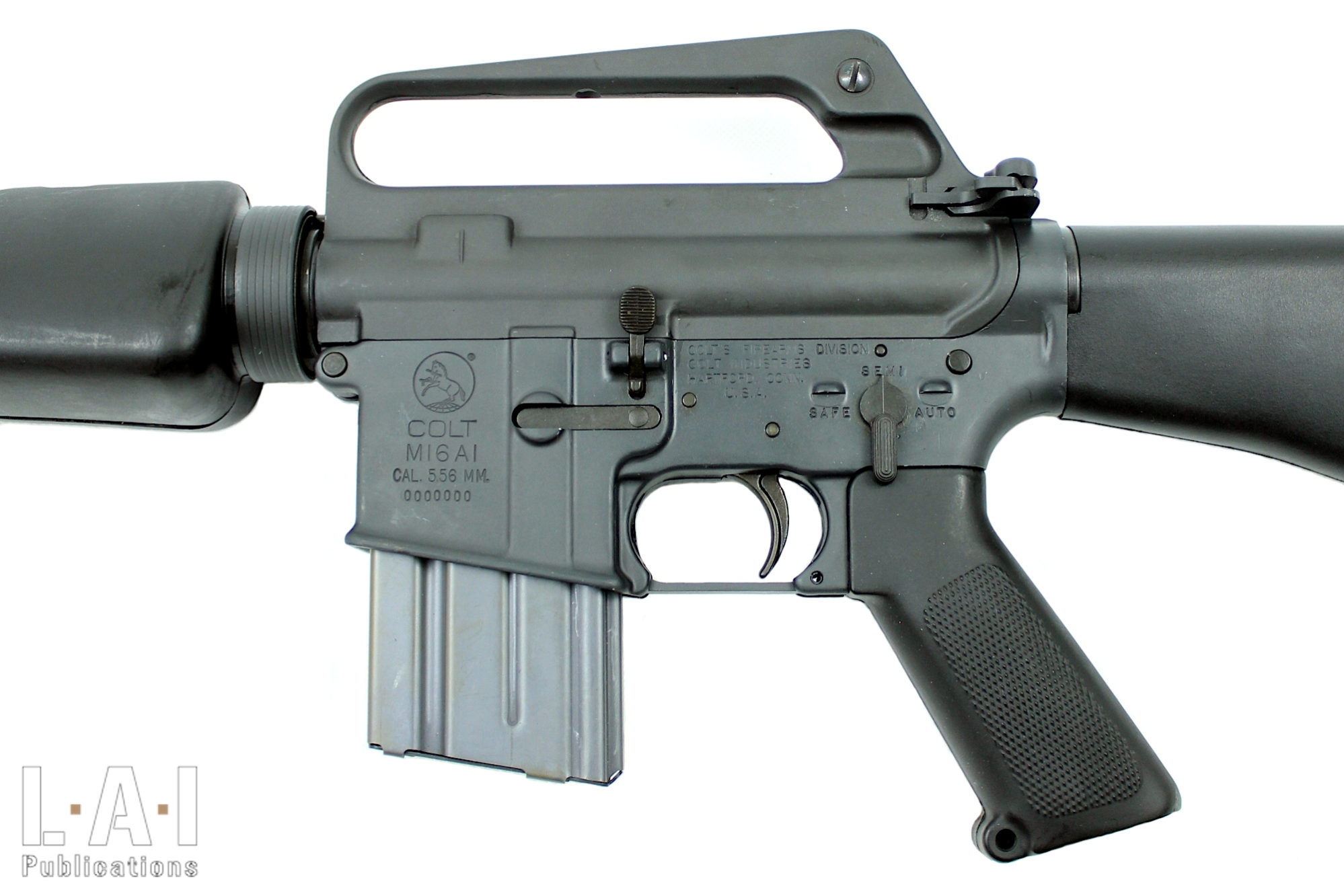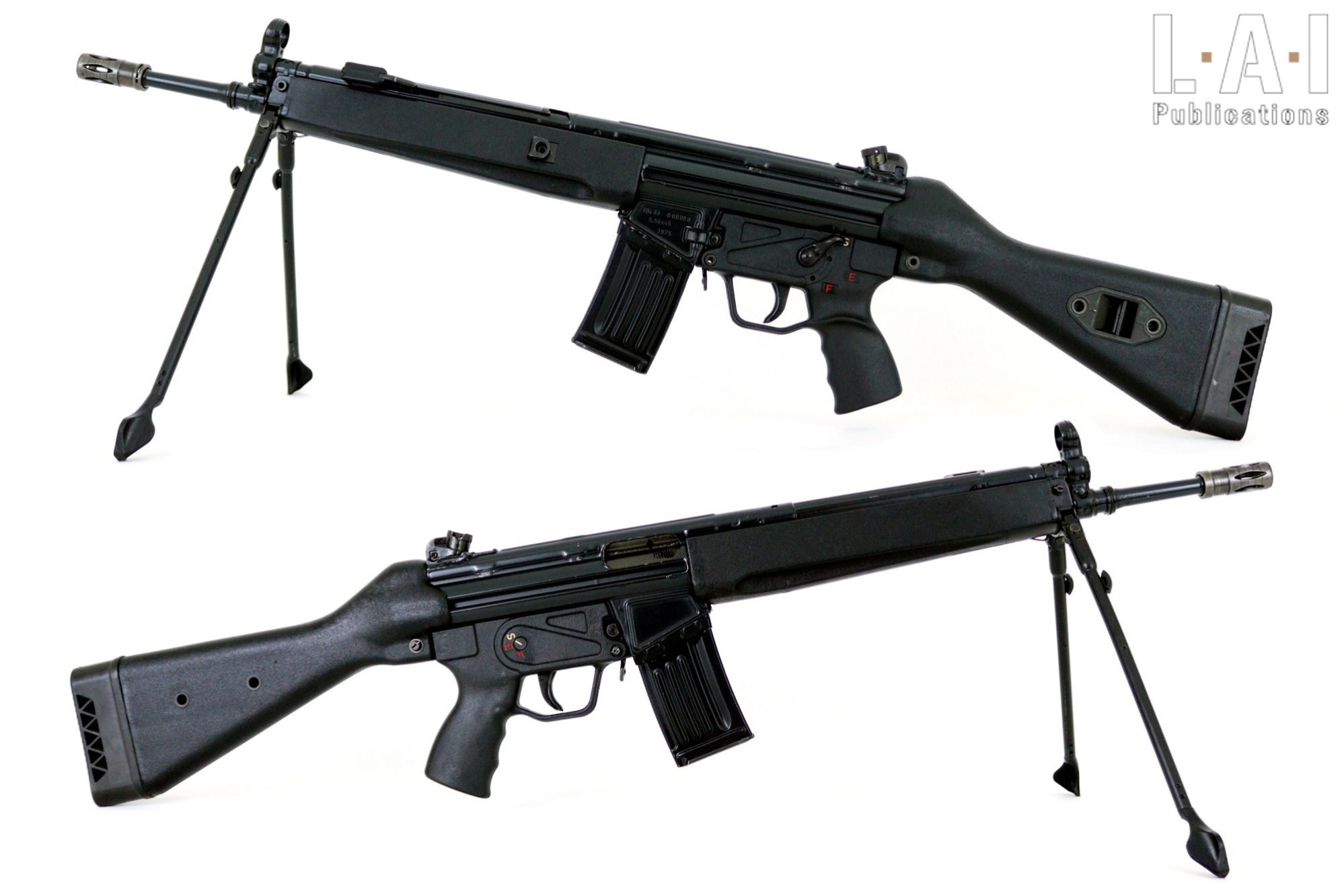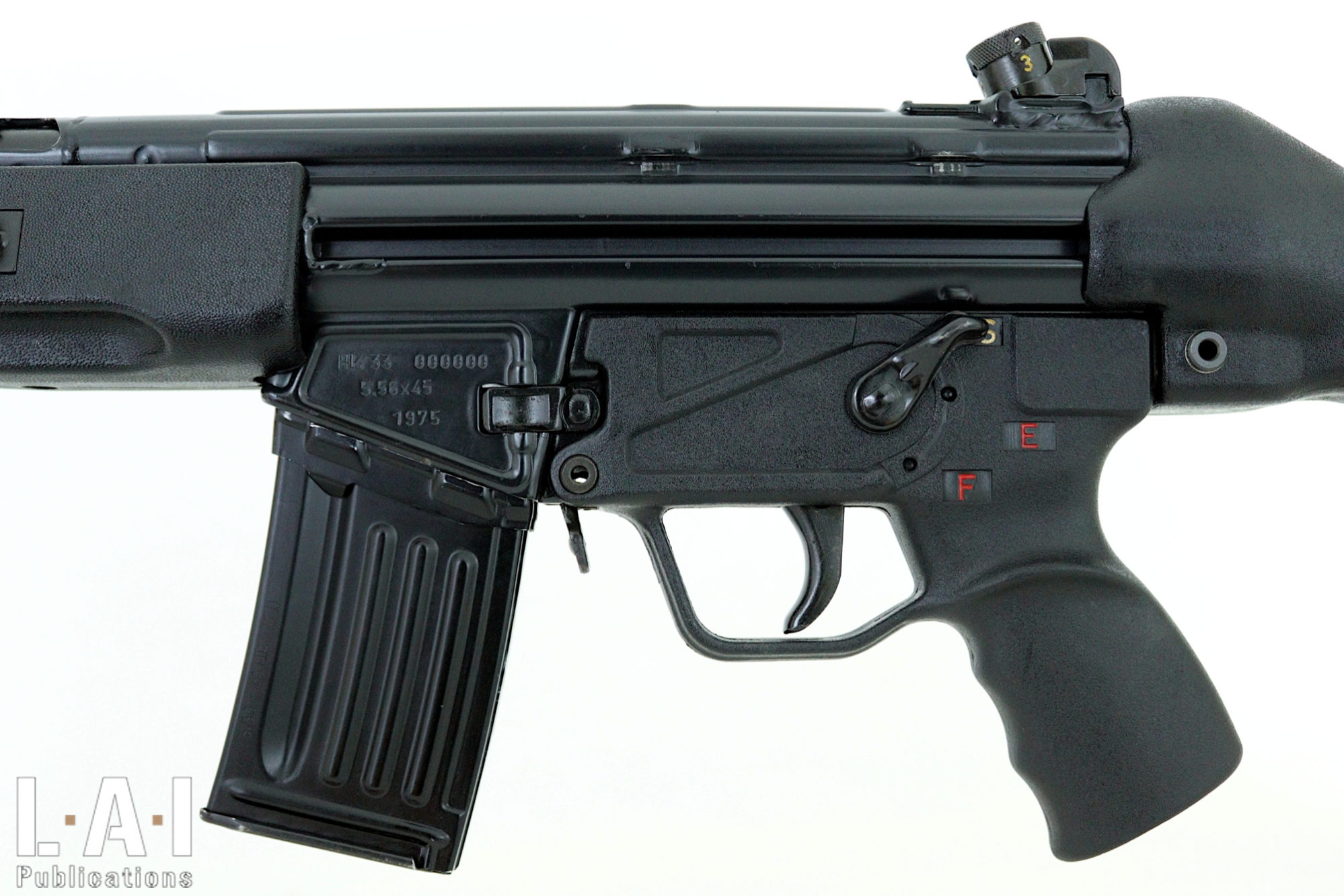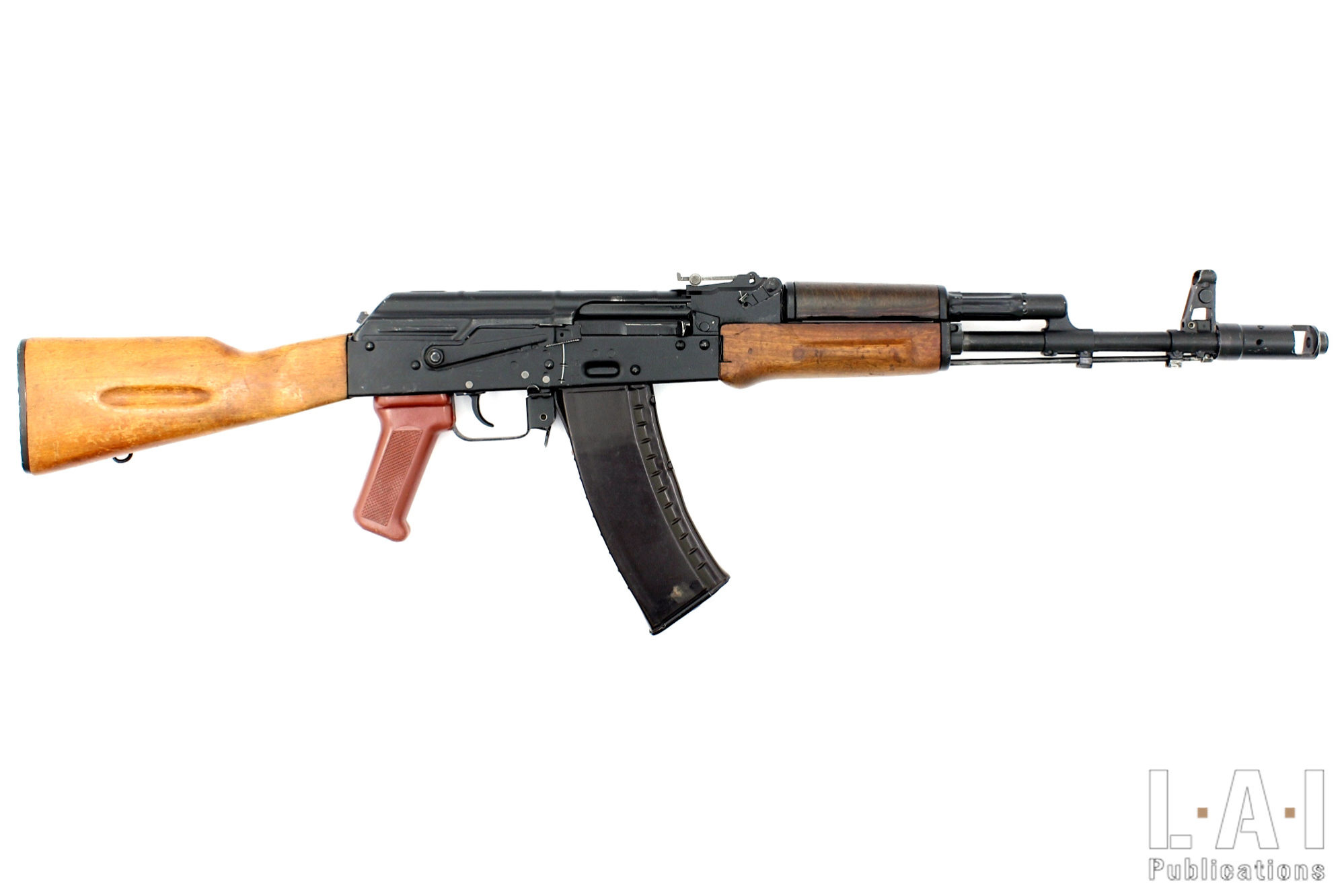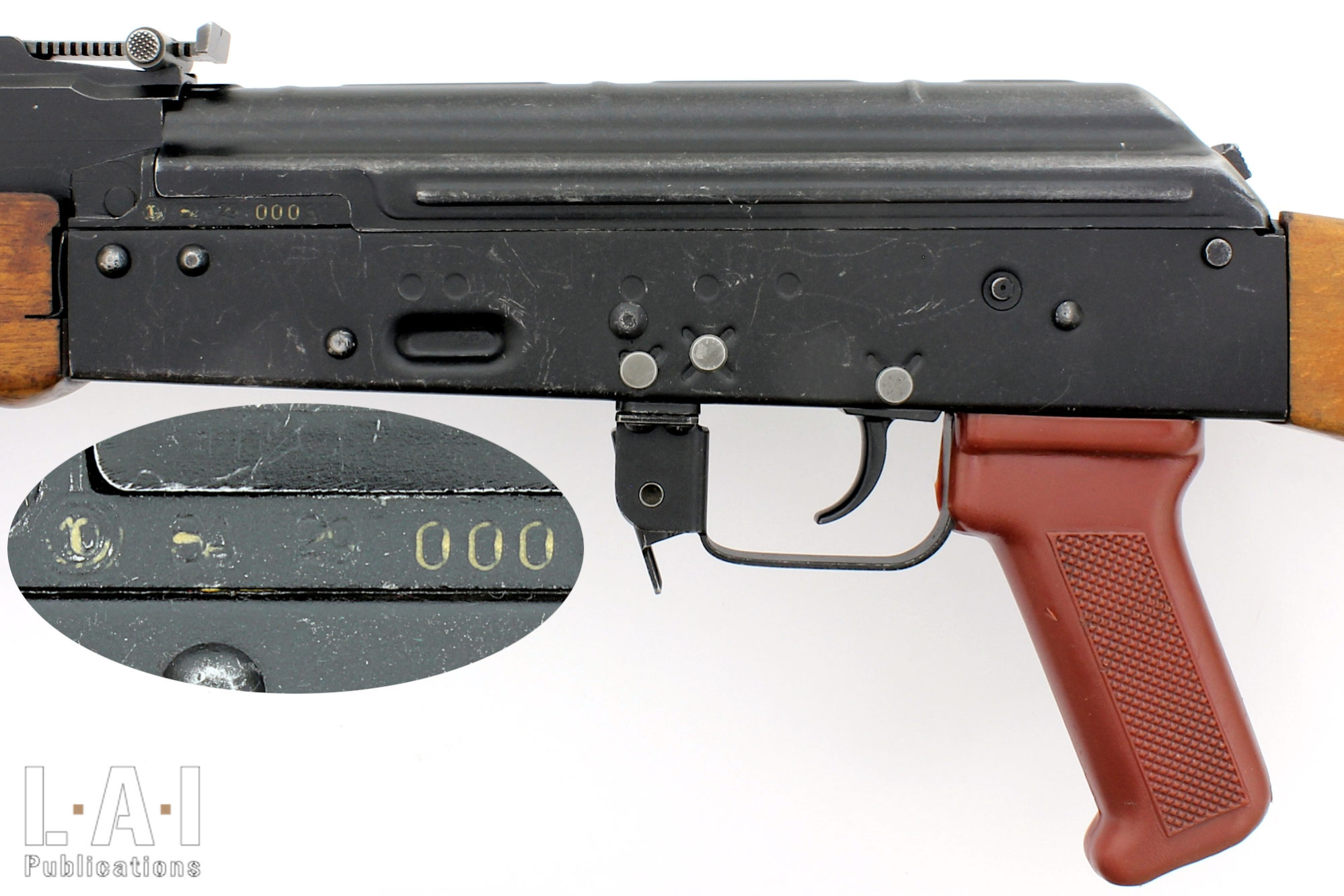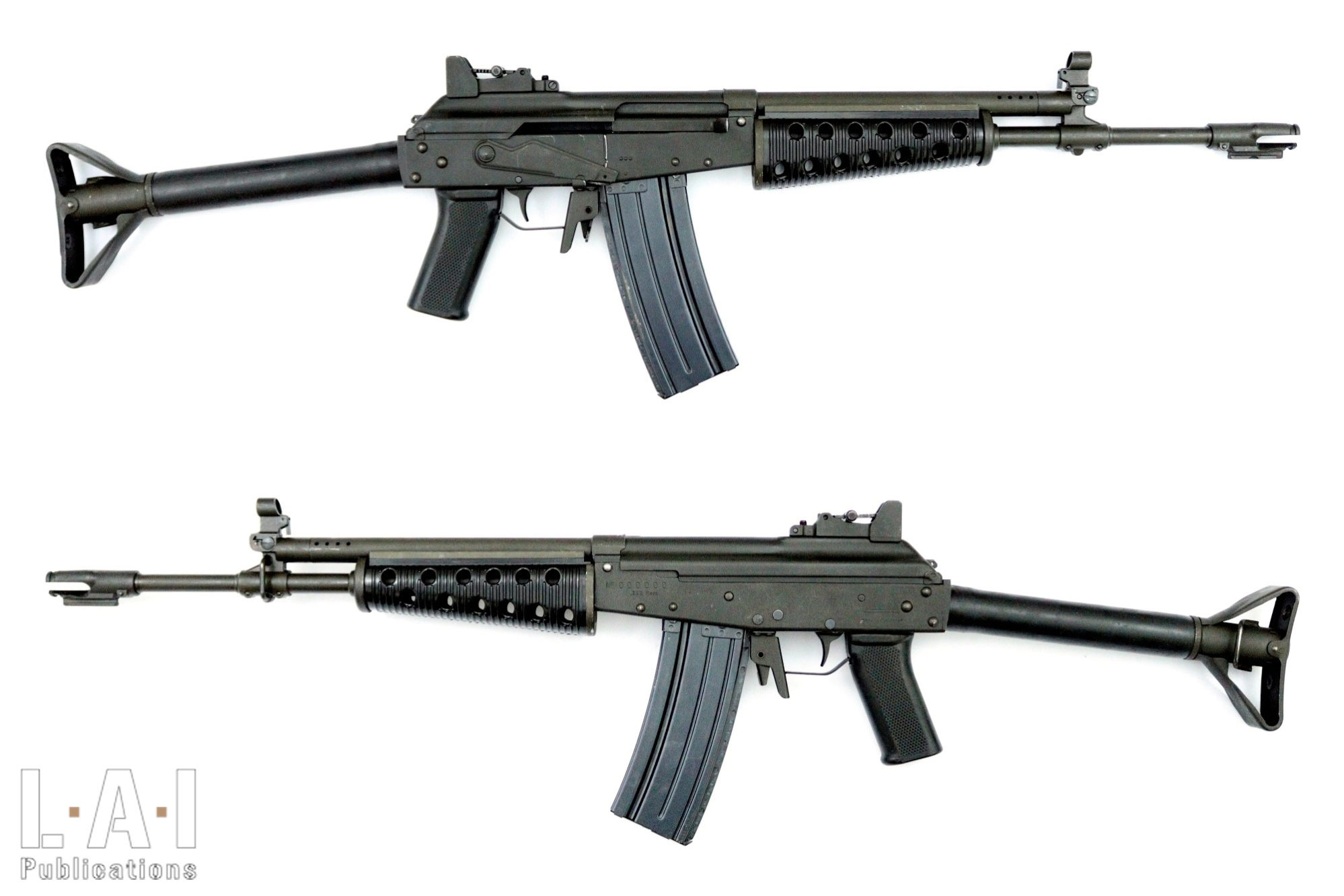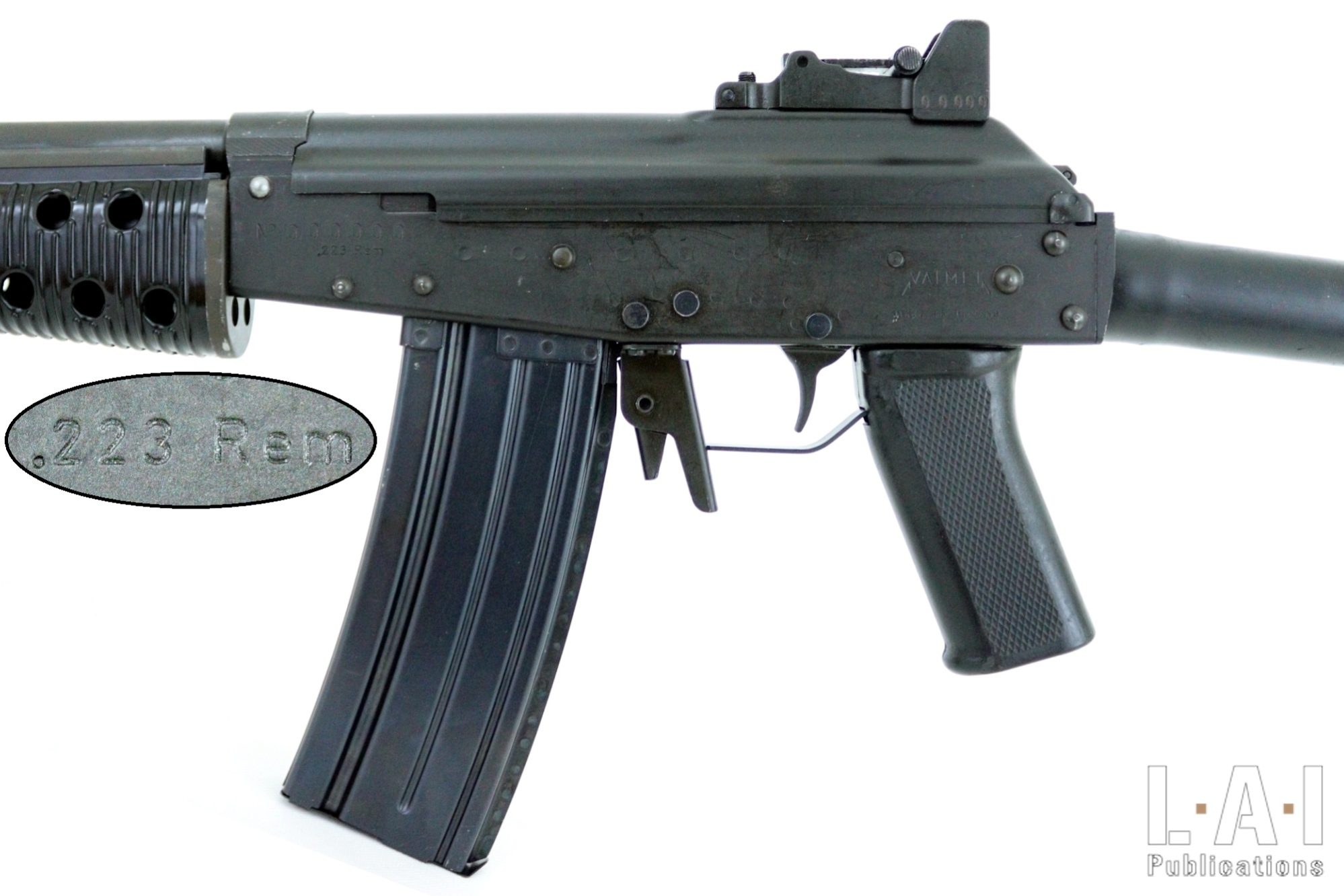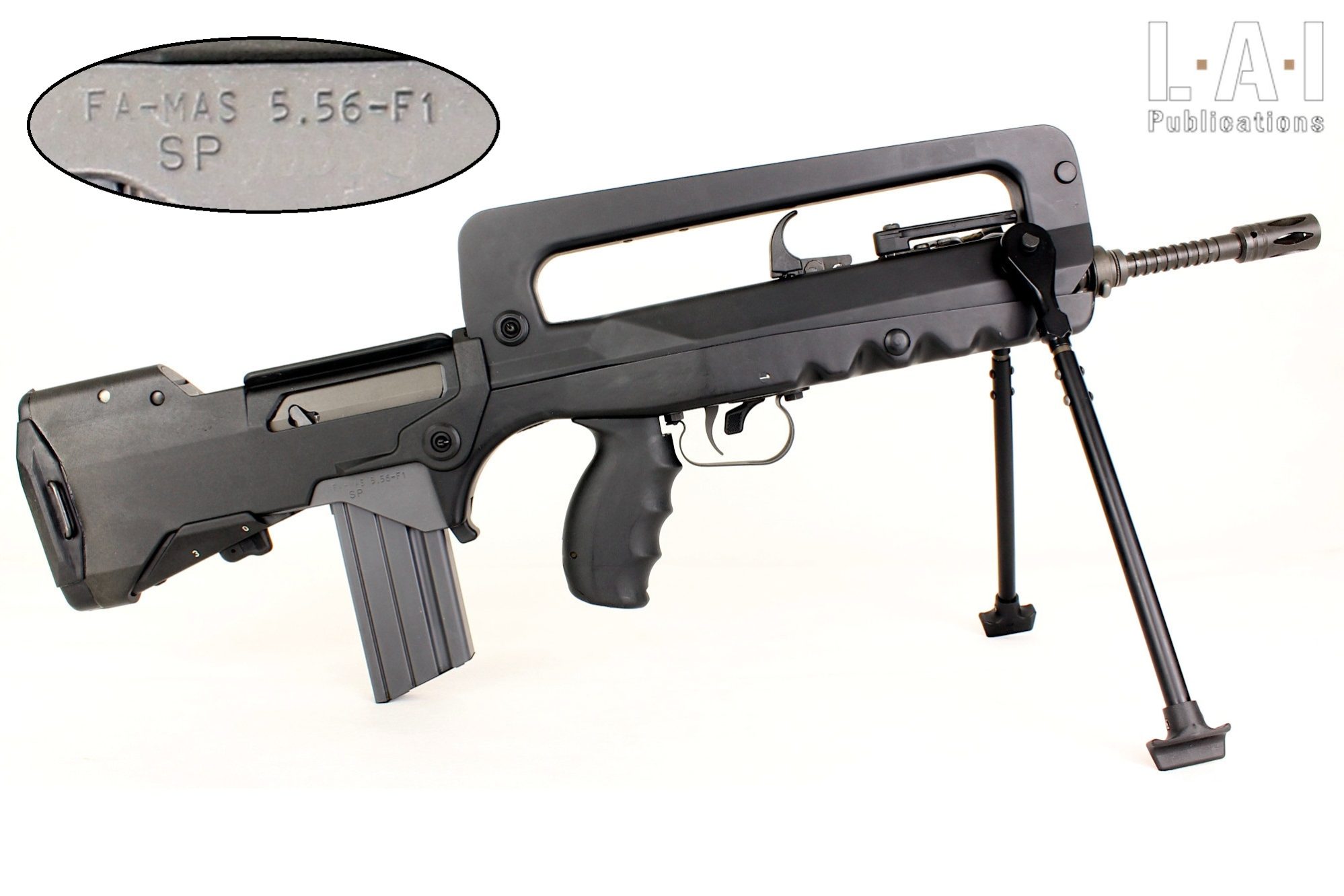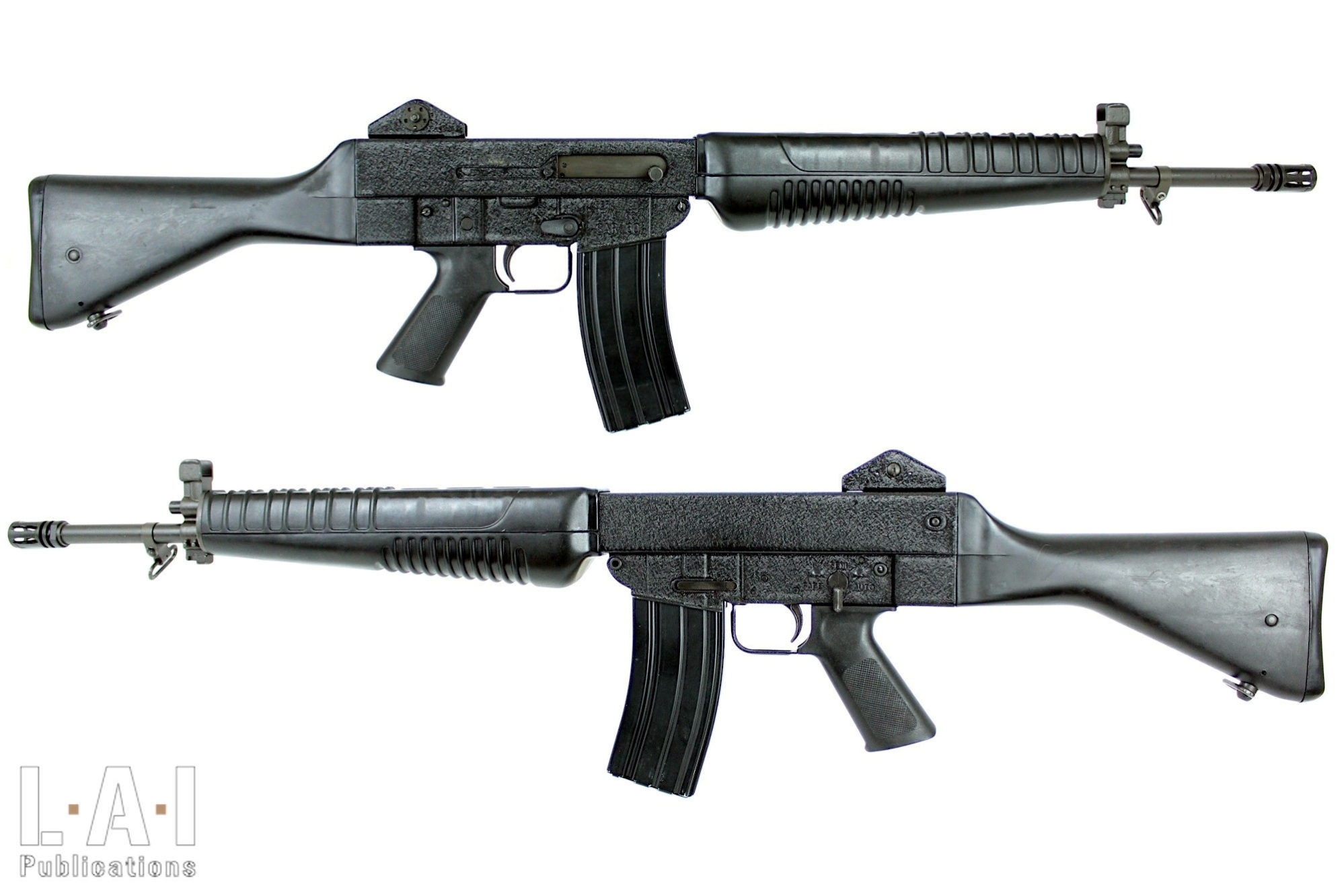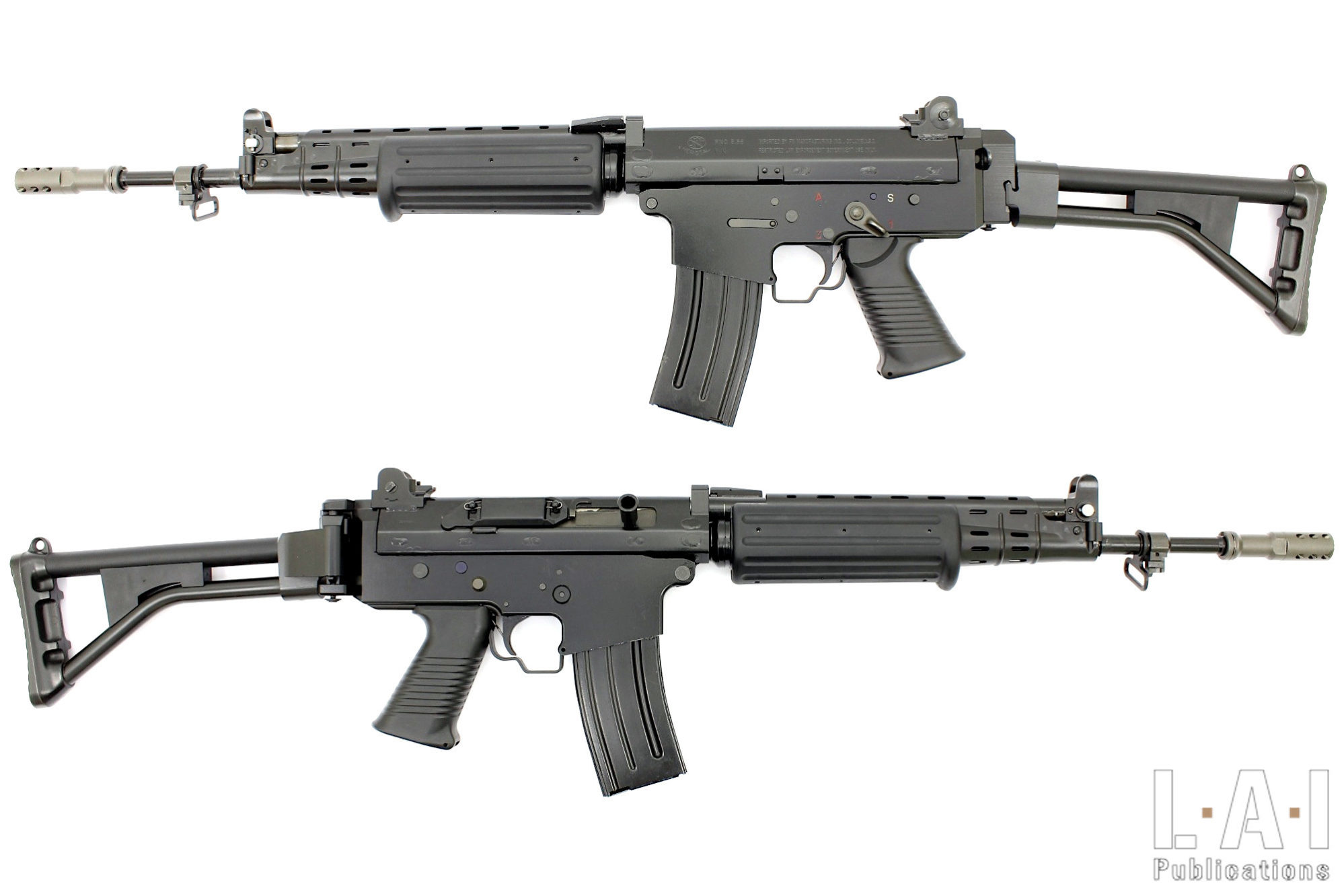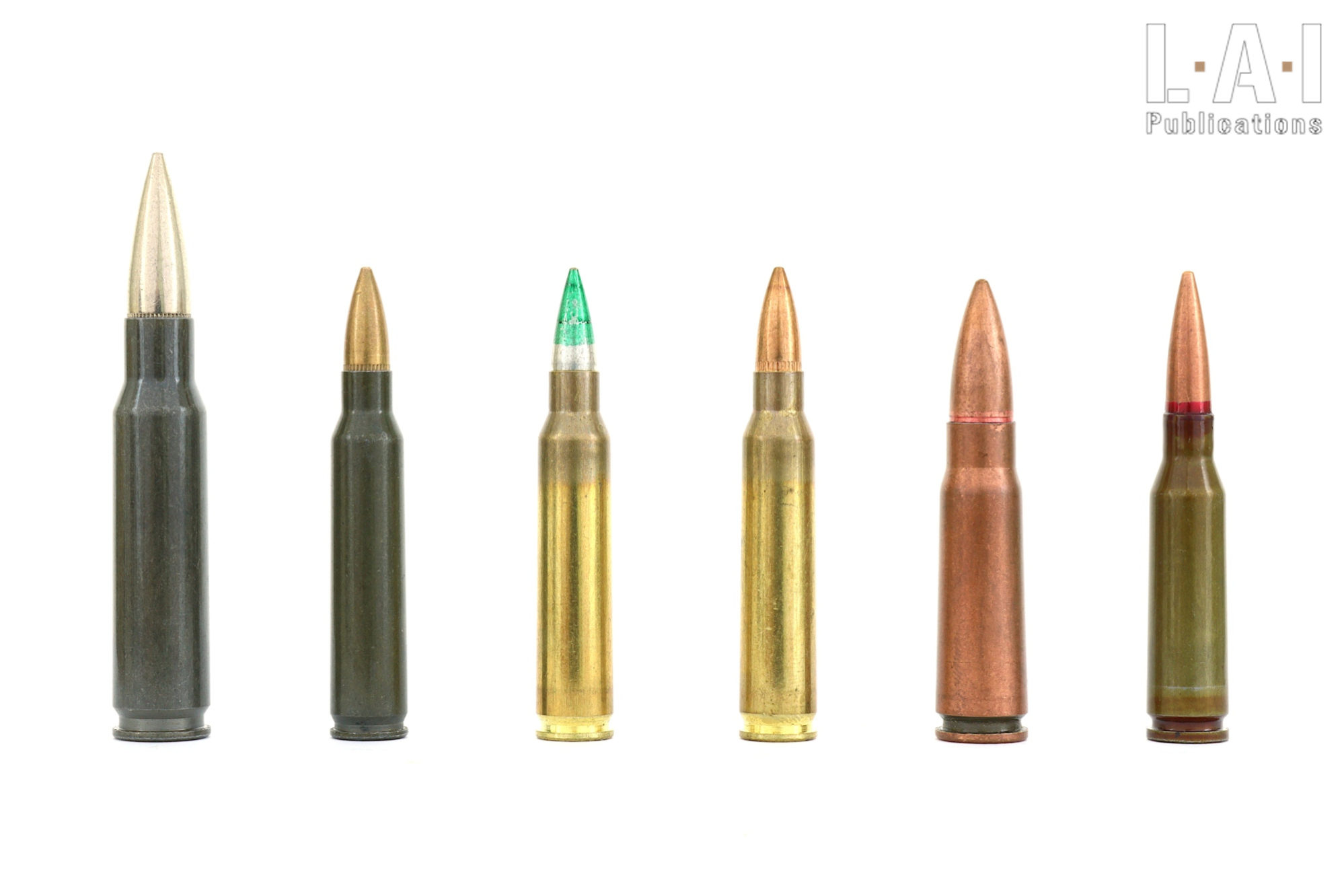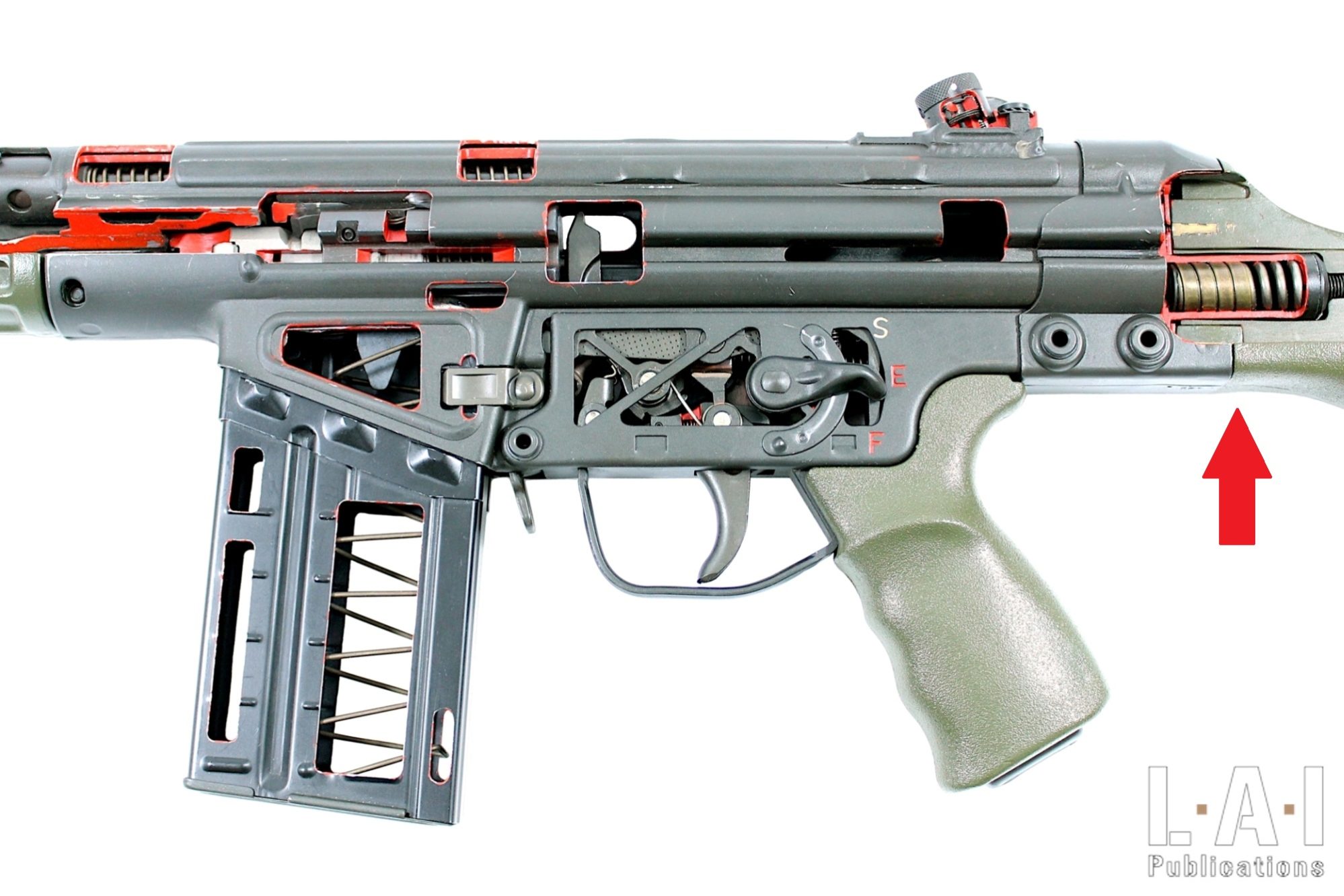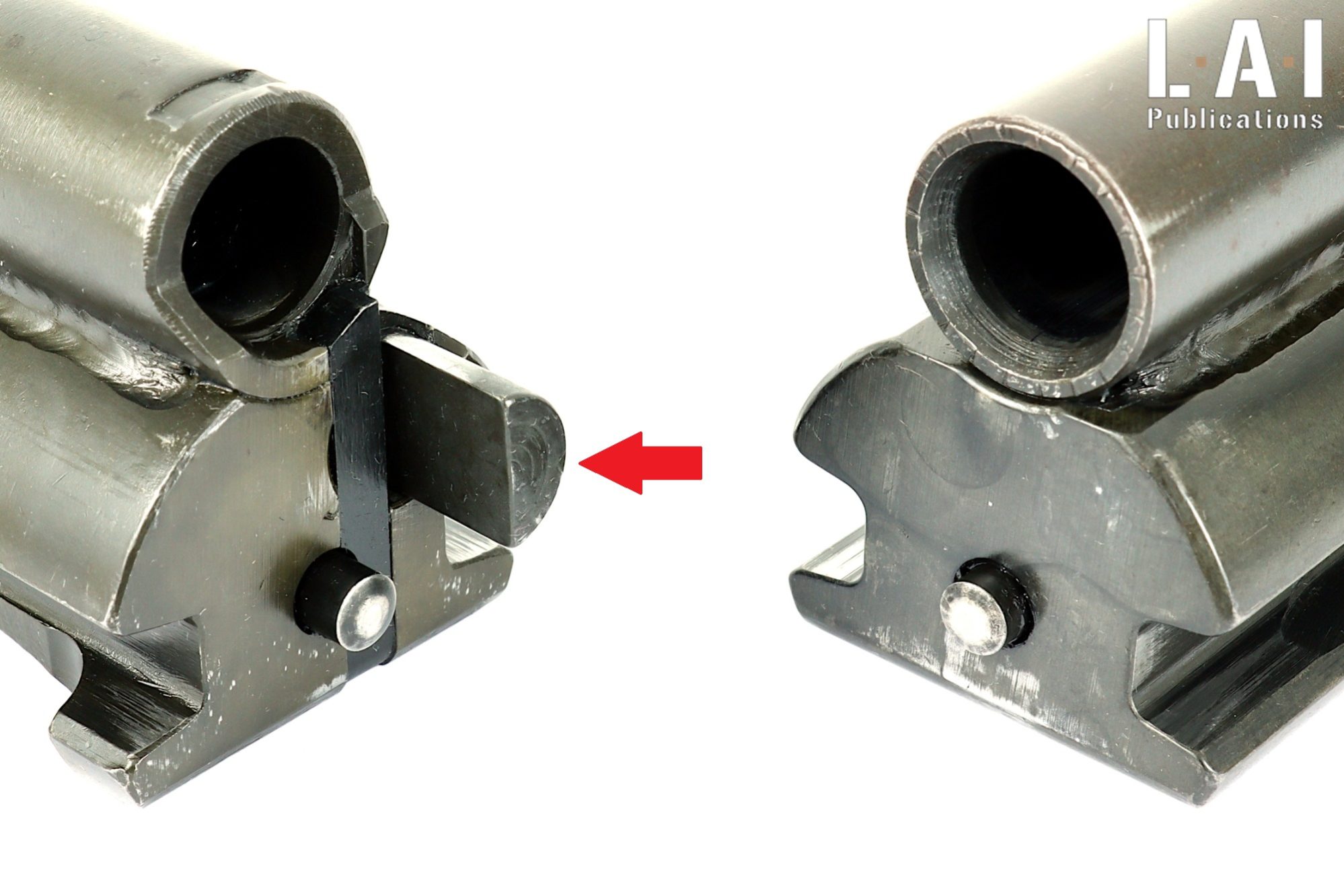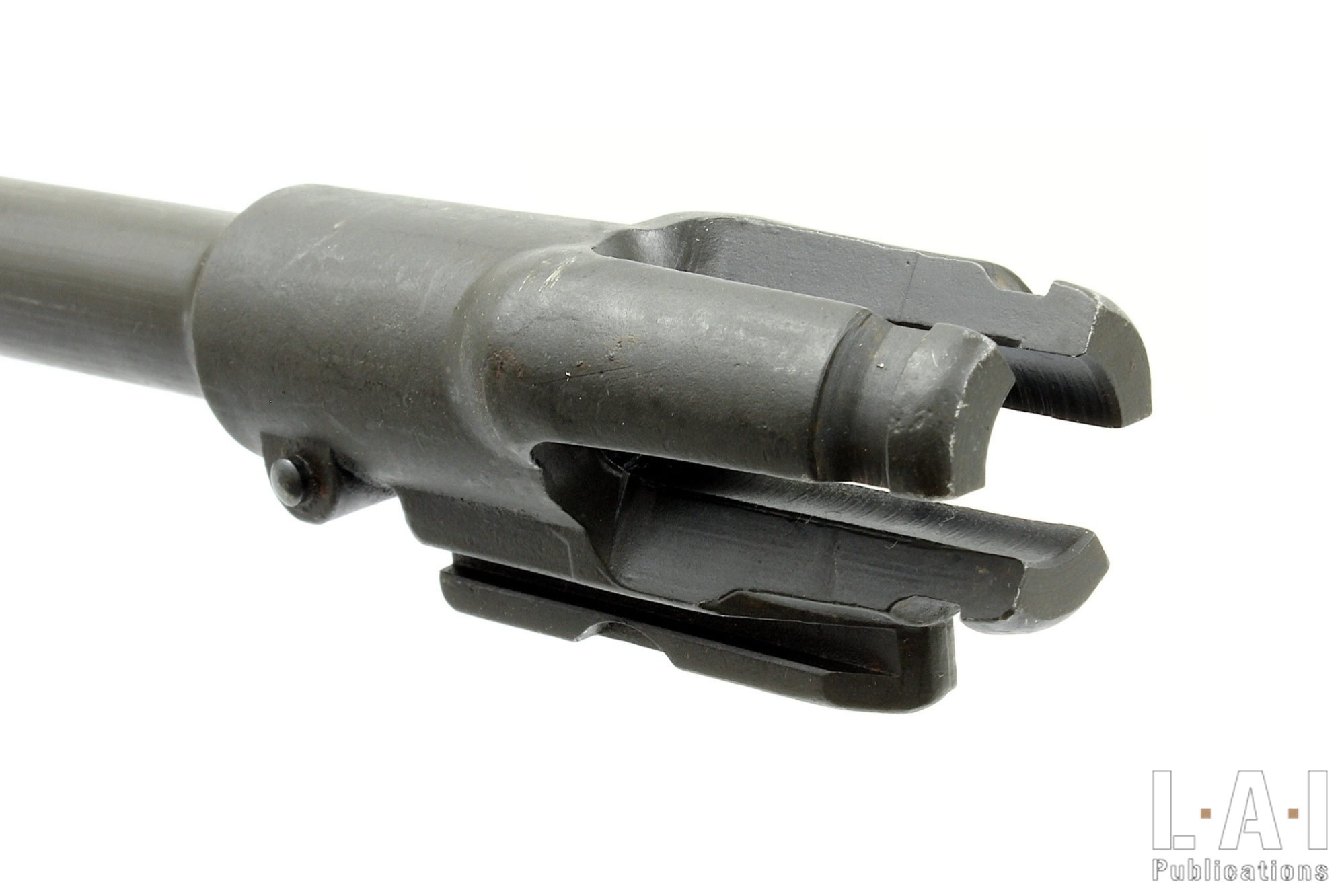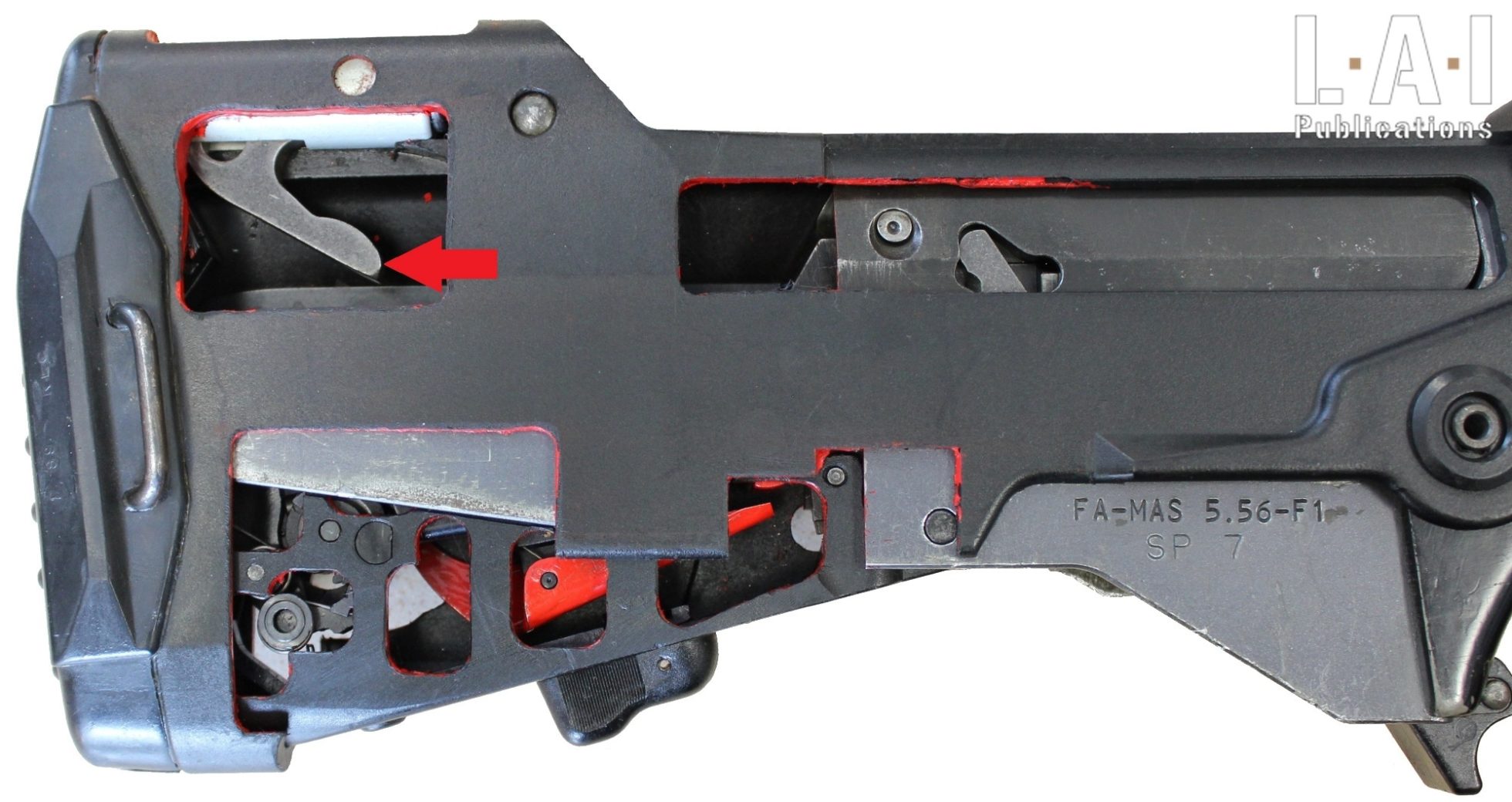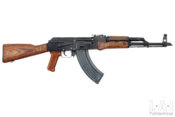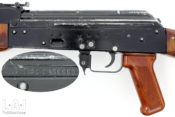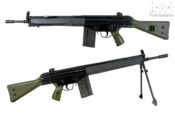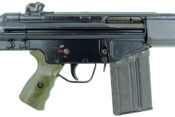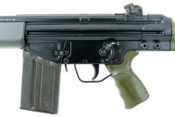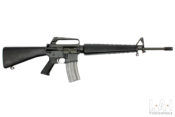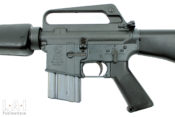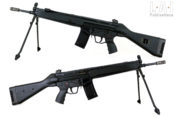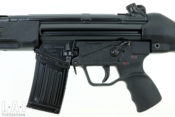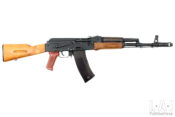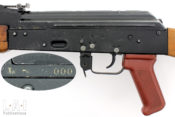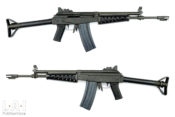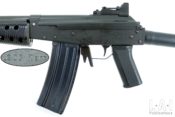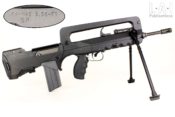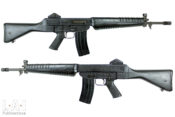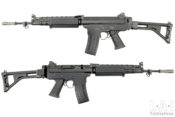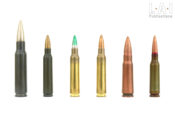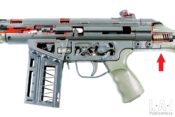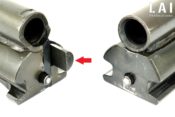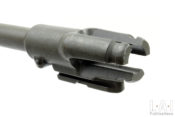Assault rifles: How they behave? (Part 2)

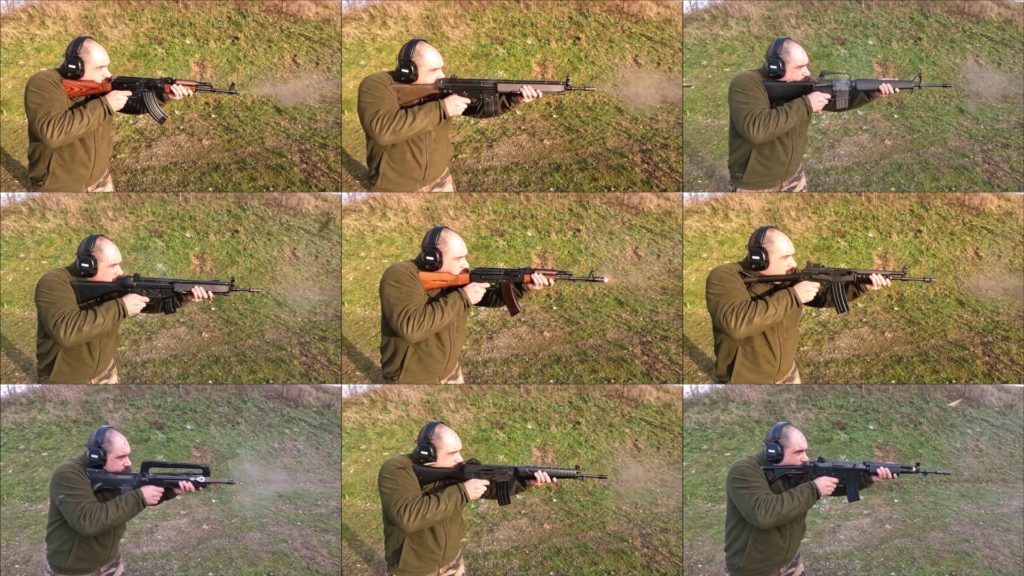
The first article of this work on the behavior of the assault rifleAn assault rifle is a weapon defined by the use of an "inter... More obviously left the door open to further experimentation. The purpose of this work is always the same: it is not a question of making a ranking, but of identifying keys to understanding that everyone can use to forge their own opinion. So that’s what we’re going to continue to do here by including 6 new weapons in this study. Obviously, reading the first part (linked here and in free access!) is more than recommended, because we will not go directly to the point and avoid as much as possible, repetitions.
The panel choices
The first part of this work offered a key place to the weapons of the Eastern-bloc countries. We have therefore chosen here to balance the study with the productions from the “Western sphere of influence”. The latter expression is undoubtedly open to criticism in many respects, but we are trying to “simplify” a problem about the Cold War period. Because yes, we globally remain focused on weapons produced during the Cold War. Due to the comparative nature of this work, we have obviously kept some of the weapons seen in the first part. They will not be compared with each other as this work has been already done. The panel is still substantial: in addition to the AKM, AK-74 and M16A1 already present on the previous study and kept here for comparison, we added HK33, Valmet M76, SAR-80, FAMAS F1, FNC and to extend the debate, an HK G3 in 7.62×51 mm, which is not an “assault rifle”, but an automatic infantry rifle, or so called “Battle Rifle” (Pic.01). A total of 9 weapons, for this part, bringing the total to 13 weapons for both articles.
Some preliminary observations:
- As mentioned just above, the G3 (the “G-Drei” for intimates) is not an assault rifleAn assault rifle is a weapon defined by the use of an "inter... More, but what should be called a “7.62×51 mm caliber automatic individual rifle for combat up to 600m“. Well, it’s less sexy than “Battle Rifle”, but at least we know what we’re talking about, right? Indeed, an “assault rifle” essentially uses an intermediate caliber for engagements at shorter distances: about 300 to 400 m. And again, no, the 7.62×51 mm cannot claim, by its level of power, to be an intermediate cartridge. So why include it? Because, when we talk about Western individual automatic weapons of the Cold War, 7.62×51 mm weapons are over-represented at the beginning of the period: M14, FAL, G3 to speak only of the most famous and those which were carving out the lion’s share in the international market. In fact, it should be said above all – again for those who read us assiduously – that it is mainly that the West has been slow to adopt an assault rifleAn assault rifle is a weapon defined by the use of an "inter... More. Similarly, the inclusion of a submachine gunSubMachine Gun More, in 9×19 mm (even in .45 ACP, but this is more anecdotal during the Cold War) would not be absurd… to meditate… for a third part?
- The date of design of the weapons is quite similar to that of the previous article, the oldest weapon being the G3 (late 1950s… or even 1945 if we make a filiation with the Stg.45 (h), but it may be a little far-fetched!), the most recent, the FNC (1980).
- We chose not to put the AK-47 in the panel: the choice of the AKM, adopted in 1959, seemed more consistent with the dates of commissioning of the other assault rifles of the panel.
- Clearly, the M16A1, the “flagship” weapon of the 5.56×45 mm, especially in this period, will serve as a “standard”. Therefore, we will compare it to all other weapons in 5.56×45 mm. However, comparisons between other 5.56x45mm weapons in the panel will be made only if that they seem relevant to us.
Finally, we would have liked to include here some other weapons, and in particular:
- The M16A2: it would be interesting to compare its behavior with the M16A1’s, obviously by dedicating the right ammunition to each weapon. However, the lack of a fully automatic mode remains problematic in the exercise: it would therefore require an M16A3. But the latter are even more complicated to find, at least in our latitudes.
- An assault rifleAn assault rifle is a weapon defined by the use of an "inter... More from the British SA-80 family: an L85A1 or A2.
- The Steyr AUG (in its early variations). We tried the weapon a long time ago and remember something particularly stable in bursts.
But we do what we can with what we have!
The forces at play
Small presentation of the material, in chronological order of adoption… with some repetitions from the first part…
The AKM (commissioned in 1959): the copy of this test is a Radom PMKM (Poland), a variant very close (not to say, almost identical) to the Soviet AKM (Pics.02 and 03). It is equipped with the slanted climbing compensator adopted around 1965 (we will make a detailed test on this device in a future work). The weapon is in its original condition.
The Heckler und Koch G3 (commissioned in 1960): our copy is a “G3A3” weapon from the stock of the Lebanese army (Pics.04 and 05). It is marked MAS (Manufacture d’Armes de Saint-Étienne) … although according to our information, no G3 has ever been manufactured at the MAS or elsewhere in France! No, it seems that the reason for this markings (on weapons manufactured by H&K in Oberndorf Am Neckar) is purely… a legal “trick” vis-à-vis export issues (Pic.06). At your convenience, you can replace the word “Trick” with the word “Scam”…
The M16A1 (officially commissioned into the US Army in 1967): the copy of this test is a Colt that would come (according to an internet source) from a batch of weapons sold in the Philippines. Original condition… (Pics.07 and 08). It can be noted here about the date we use that variants of the AR-15 rifle have had field use since the early 60s. But here we are particularly interested in the model at our disposal. Thus, we chose to retain its official adoption year in the US Army.
The Kechler und Koch HK33 (put into production 1968): a Heckler & Koch manufacture with a small specificity for (to our knowledge) French contracts: the stock is equipped with a thicker rubber butt plate intended to cushion rifle grenade fire, dear to the French Army (Pics.09 and 10). This stock was installed by your servant as a replacement for the telescopic stock… which is infamous for shooting purposes!
The AK-74 (commissioned in 1974): the copy of this test is an Arsenal (Bulgaria), designated AR-M1 in the book of F. lnammico and AKK-74 (Avtomaticheskiy Karabin Kalashnikova) in the book of John Walter (Pics.11 and 12). Here too, a weapon almost identical to the Soviet AK-74. It can be noted that the stock and the lower handguard use raw wood while Soviet productions use laminated wood. The muzzle device is type 2. The weapon is in its original condition.
The Valmet VALMET M76 (put into production in 1976): a pure Valmet copy (Pics.13 and 14). Here we are in the presence of a weapon widely treated in one of our articles here in link,… So, for the most curious or eager for information, just click. In the desire to put in this panel a “Western” “copy” in 5.56×45 mm of the AK-47, we could have put here a Galil ARM, but the Israeli “Assault RifleAn assault rifle is a weapon defined by the use of an "inter... More Machine gun” is a little bit heavier for an assault rifleAn assault rifle is a weapon defined by the use of an "inter... More. We preferred a slightly lighter weapon.
The FAMAS F1 (commissioned in 1979): here too, the weapon is in its original condition (Pic.15). Here too, an article of your servant is available on the site, so same treatment. Having the chance to have access to an F1, it would have been a shame to deprive ourselves of this experience. In addition, the behavior of a mechanical advantaged blowback (by a lever) seems interesting to us to compare with other types of mechanisms, including the mechanical advantaged blowback by roller of the G3 and HK33. We devoted a lot of the work to it… LAI Publications oblige! Moreover, it can be noted that this is the only “bullpup” of the panel.
The SAR-80 (put into production in 1980): CIS production, original condition (Pic.16). And here too…Your servant’s article is available on the site and linked here! The choice of a mechanism and construction close to the AR-18 seemed interesting to us, especially in comparison to the M16A1. Be careful, the AR-18 and SAR-80 still have some differences, especially on the stock slope, more “conventional” on the SAR-80 than on the AR-18. The gas regulator is in position “1” for this test.
The FNC (first order in 1980): original condition (Pic.17). So, here we go again, the article is available on the site and linked here. Although today rather relegated to oblivion (in my opinion, wrongly …), this excellent rifle has long been considered one of the standards by NATO institutions. The gas regulator is in the “Normal” position for this test.
As in the first part, the stocks are fixed here… or comfortable enough not to interfere with exercise. Shooting a G3 or HK33 with the telescopic stock would have been an injustice…
We used the following ammunition (Pic.18):
- For the G3 caliber 7.62×51 mm: French service ammunition “7.62 N” lacquered steel case, compliant with the M80 (10 g bullet). This type of ammunition, normally devolved to the AAN-F1, is perfectly adequate with the operation of the G3 although to our knowledge, the German service ammunition was not equipped with a steel case, but a brass one.
- For the HK33 and FAMAS F1 caliber 5.56×45 mm: French F1A service ammunition close to the M193 specification (same bullet weight), lacquered steel case. Both weapons, by their similar operation, are particularly suitable for the use of this ammunition … for the FAMAS F1, it is even its OWN ammunition.
- For the FNC caliber 5.56×45 mm: MEN SS109 ammunition, brass case.
- For M16A1, SAR-80 and Valmet M76 caliber 5.56×45 mm: MEN M193 ammunition, brass case.
- For the AKM caliber 7.62×39 mm: Chinese-made military ammunition type M43, copper steel case.
- For the AK-74 caliber 5.45×39 mm: Soviet-made military ammunition late 7-N-6, lacquered steel case.
In this kind of exercise, the choice of ammunition is not to be taken lightly: not all ammunition is created equal… Far from it. We can’t repeat it enough… Yes, this sentence is reproduced identically from the first part… But as already said: we can never repeat it enough!
Our revisited protocol
In our previous test, we chose to conduct the test with 30-round magazines, which was the “standard” capability of most of the weapons presented. Here, we aligned ourselves with the smallest capacity: that of the G3, 20-round. If this quantity is less spectacular than the usual “30-round”, it is finally more than enough to:
- Make accurate cyclic rate measurements.
- Give the shooter’s body time to “stabilize the weapon”, even with the G3 (the weapon that opposes the strongest recoil) or with the FAMAS (the weapon that produces the highest cyclic rate in the panel with 4 digits on the counter… “cocorico” so to speak…).
For each weapon, a 20-round burst was filmed (with a GoPro 10) at 240 frames per second. The exploitation of the films allowed us to determine a cyclic rate from the first “smoke at the muzzle” to the last “smoke to the muzzle”… Excel doing the rest. It should be noted that here, the cyclic rate is only indicative, and alone, does not allow any conclusions to be drawn.
The shots were made in January 2023, filmed at the end of the day. The weather was mild for a January month in metropolitan France: the presence of clouds explains the variation in brightness between the videos. The weapons were filmed in the following order: G3, AKM, AK-74, M16A1, SAR-80, HK33, Valmet M76, FNC and finally FAMAS F1. All the weapons had already been fired before the shooting, but their barrels were cold at the time of the shooting. The shooter – your servant – was already well-seasoned to the exercise… which took place within shooting campaigns lasting several days.
The presentation of the comparisons will be done by adoption chronological order.
From one article to another…
The writing of this article was an opportunity for us to make a small update in the first part. We invite the bravest to re-read this article and in particular the paragraph “Our protocol” and “My way of watching this type of video”. We have already presented a number of important elements for the understanding of this article, and we will not go back over them here so as not to unnecessarily add to an already long article! Similarly, the prior reading of the article “Some thoughts about burst shooting”, of your servant, will also be a plus to the understanding of this article.
Seeking to improve the analysis process, we have added in these new videos two comparative sessions, making overlayed footages of the compared weapons:
- The first synchronized on the first shot: it allows to compare the beginning and the middle of the burst and to appreciate the differences in cyclic rate.
- The second synchronized on the last shot. These are amputated from the beginning of the burst so as not to make an unnecessarily long video: they allow a better comparison of weapons at the end of fire.
Despite the confusion of comprehension sometimes induced by overlaying (especially on the behavior of the shooter’s body), we feel there is a lot to be learned. We also tried to add colored lines to materialize the angle of the barrel on the first shot, but the result did not seem conclusive, and even confusing: we did not keep them.
For the sake of consistency, we will probably re-edit the videos of the first article with this new type of sequence.
1. G3 & AKM
Measured cyclic rate on the sequence:
- G3: 20 rounds in 1.60 seconds, or 750 rpm.
- AKM: 20 rounds in 1.81 seconds, or 665 rpm.
What is visible on the video:
The G3 moves back in the shoulder much more than the AKM, but on the footage, this could seem “acceptable”… We will come back to that. The barrel of the G3 does not benefit from a climbing compensator, it rises “freely” compared to the AKM, which is brought back in line energetically with each shot, or even slightly lowered below the line of the previous shot. But the climbing of the G3 finally seems “weak” if we take into account the energy difference between the two munitions:
- 3200 J for the 7.62×51 mm (with a V0 of 800 m/s for a 10 g bullet)
- 2045 J for the 7.62×39 mm (with a V0 of 715 m/s for an 8 g bullet)
The 7.62×39 mm has only 63.90% of the energy of a 7.62×51 mm.
At the end of the shot, the shooter’s body sends the G3s forward with vigor and a little downwards. The weapon even takes “time” to stabilize. The forward return of the AKM is weaker, and the weapon remains overall in line.
We find a difference already observed with other weapons in the first part: the smoke of the AKM is oriented upwards and to the right, whereas the G3’s propagates uniformly forward: of course, it is the work of the AKM climbing compensator that makes the difference.
What is not visible on the video:
Obviously, the G3 requires a much stronger grip than the AKM. The exercise with the G3 is not as obvious as the images suggest, and we highly doubt that it can be replicated in the stress of a fight. Moreover, do not underestimate here the abilities of your servant in this type of exercise: I have been practicing this for a very long time, and never done it in “Mag-Dumping” mode so to speak! No, each burst shooting exercise was carried out in a well-thought-out way: position and behavior of the body (brain included!) and behavior of the weapon are always objects of study… whoever the shooter is! Seeing the images in this article, a comrade who also had the joy of testing some of these weapons said to me: “it looks like you hold the 7.62×51 mm as well as the 5.56×45 mm“! I certainly have some practice of this type of equipment, but automatic fire with this type of weapon from off-hand, whatever the position (standing, kneeling or in prone position), does not seem exploitable to us. If in the image, the climbing of the G3 is not as impressive as the caliber 7.62×51 may suggest, make no mistake: it climbs enormously and it is easy to be very fast much above the target, even at close distances. Here, the exercise is conducted near a good-sized shooting backstop… And that’s a bare minimum to avoid blunders. To extend the question about individual automatic weapons in 7.62×51 mm, one might ask, “What about the use of a bipod?” Well, the thing is not presented here, but having already conducted the test with G3, FAL, HK-417 … Well, it’s not conclusive either. In our opinion, the presence of the automatic firing mode on this type of weapon only allows… to sell the product as having this capability, although it is not exploitable. Yes, it’s a scam… Many armies using 7.62×51 mm caliber rifles (or close power) will not be mistaken in limiting these service weapons (from design or after their commissioning) to semi-automatic mode.
On the AKM side… Well with a correct grip, the burst remains very controllable. With a tense or unnecessarily manly grip… Well, we tend to go down!
On this comparison:
We start here with the comparison with the two oldest weapons on the panel. Obviously, comparing 7.62×39 mm and 7.62×51 mm makes little technical sense. A specification that would lead to propose one of these two choices would be the result of a very poorly expressed need… But from a historical point of view, why not: on a large portion of the Iron Curtain, it is these two weapons that stared silently at each other for many years! And it also makes it possible to set the “record straight” on the individual automatic weapons in 7.62×51 mm.
2. G3 & M16A1
Measured cyclic rate on the sequence:
- G3: 20 rounds in 1.60 seconds, or 750 rpm.
- M16A1: 20 rounds in 1.54 seconds, or 778 rpm.
What is visible on the video:
Surprisingly (or not!), at the beginning of the burst the movements of the two weapons are finally close in terms of direction, with an amplitude difference:
- Relatively important for the recoil.
- Relatively low for the climbing.
And yet:
- The 5.56×45 mm M193 is 1719 Joules (with a V0 of 991 m/s for a 3.5 g bullet)
- And 7.62×51 mm M80; it is still 3200 Joules as seen previously.
So still much less than a 7.62×39 mm: 53.72%! The difference in recoil is even noticeable on the shooter’s body: the ripple caused by the G3 is significantly greater than the M16A1’s. The similarity in the behavior is partly explained, because the two weapons have in common to feature the barrel in the axis of the upper part of the stock. The thing is less obvious on the G3 because the general layout of the weapon is developed a little more above the barrel because of the cocking handle tube. Where the M16A1 stands out is obviously on the housing of the recoil spring, in the alignment of the barrel and inside the stock. On the end of the shot: both weapons dive forward and down: logically the body produced the same compensation in terms of direction, but not with the same amplitude.
What is not visible on the video:
Yes, it’s obvious, the G3 is much more complex to master than the M16A1 … but the M16A1 requires a certain grip to avoid an excessive climbing, and which is not so obvious as that. We pointed it out in the first part of this work: with its climbing compensator, the AKM is a little easier to use in this exercise than the M16A1.
On this comparison:
Comparing 5.56×45 mm with 7.62×51 mm obviously makes no more sense from a technical point of view than with 7.62×39 mm as seen previously… But it makes just as much sense historically speaking! And it ultimately remains rich in teaching.
Moreover, this comparison seems to us to be enough to evoke a problem perfectly illustrated here: the energy difference of bolt carrier groups (BCG). By approaching the thing under the aspect of a simplified energy balance (i.e. only the energy related to the BCG movements alone on its average speed), we have the following data:
- For the G3, a 778 g BCG moving on a 165 mm stroke (before contact with the buffer). So, for a 750-rpm cyclic rate: 6.62 Joules per cycle.
- For the M16A1, a 471 g BCG (including buffer) moving over a 108 mm stroke (before the buffer enter in contact with the stock). So, for a 778-rpm cyclic rate: 1.85 Joules per cycle.
So, 3.58 times more energy for G3 than for the M16A1. For the rest of the weapons in the panel (extended to a few other weapons for comparison), the energy is contained in a closer range (in ascending order):
- SAR-80: 1.55 Joules including 0.02 Joules for the movement of the piston alone. The lowest value of the weapons on the panel.
- AKM : 2.17 joules.
- AK-74 : 2.27 joules.
- FNC : 2.32 joules.
- HK33 : 2.33 joules.
- For the AK-47 type 3: 2.40 joules. Calculated from the data of the first part of this work.
- Valmet M76: 2.58 joules. The highest value of the weapons in 5.56×45 mm.
- FAMAS F1: Here, the data is subject to caution, not having the means (for the moment) of knowing the mass of the cocking tube with its adjoining handle, which are part of the BCG mass at the time of firing, we have flat-rate – in view of the geometric specificities of the parts – add 100 g to the 379g of the BCG for the calculation: which gives us 2.43 Joules. By adding 80 g, which seems to us to be a “low” estimate of the mass of all the parts of unknown masses, we fall to…2.33 joules! The same value as for the HK33.
If these energy differences obviously affect the behavior of the weapon (with a backward movement, followed by a forward movement), it is difficult with the means at our disposal to accurately identify the proportion on the overall behavior of the weapon. However, it will be remembered that the Soviets worked on this problem by producing weapons with balanced BCG by counterweights: originally, they were the AEK-971 and AK-107. These works will only recently lead to the adoption of modified versions of the AEK-971: the KORD 6P67 (in 5.45×39 mm) and 6P68 (in 7.62×39 mm). Due to the increased complexity of the weapons, deployment took place only in the hands of specialized units. All for a performance gain announced at…10% in terms of hit probability up to 300 m dixit Max Popenker (Modern Firearms) on short bursts and off-hand. Some will judge that it is a lot, others, like your servant, very little in view of the sacrifices made. For the record, within the Soviet “Abakan” project which saw the birth of the AEK-971 and other AN-94, the requirements for increasing the hit probability was of… 50 to 100%. The AEK-971, working on the BCG balancing, was rejected because it did not meet these requirements. Personally, we wonder if the purchase of the 6P67 and 6P68 is not made for the main purpose of supporting the research and development effort of the Russian gunsmith industry. But that’s another debate. Back to what interests us, it would seem that the effect of moving BCG masses is rather marginal on the behavior of the weapon compared to the recoil impulse related to the shot itself. To complete the subject quickly, the winner of the Abakan project, the AN-94, will bring a higher gain than the AEK-971 by working, for the first two shots fired in burst mode, on… the delay in the perception of recoil by the shooter! The thing being achieved by two concomitant means: the acceleration of the cyclic rate to 1800 rpm and the accompaniment of the recoil of the receiver / barrel assembly inside the stock. In our opinion, this is an additional clue that makes it possible to relativize the importance on the behavior of the weapon of the BCG masses. And the weapon remains complex to say the least… for an infantry weapon!
3. M16A1 & HK33
Measured cyclic rate on the sequence:
- M16A1: 20 rounds in 1.54 seconds, or 778 rpm.
- HK33: 20 rounds in 1.31 seconds, or 914 rpm.
What is visible on the video:
The behavior of two weapons is generally similar at the beginning of the sequence, but quickly, the HK33 is a little livelier than the M16A1. In our opinion, the much higher cyclic rate of the German weapon is the main cause: it does not really leave the bodies “time to buffer”. At the end of the shot, the behavior of the two weapons is very similar… not to say identical.
What is not visible on the video:
If as already mentioned, the M16A1 requires a certain firmness in the grip during this exercise, clearly the HK33 requires a superior one! Here we will anticipate a little on the rest of this article: with the FAMAS F1, it is the most difficult 5.56×45 weapon to master from the panel of this test… let’s say even the hardest of those we have tried to date. Be careful, like the M16A1, both weapons remain “controllable” on a firing range, but we are not convinced that burst fire can be easily exploited by personnel with little experience in combat situations… at least without a bipod! Because yes, here too, the question of the bipod arises. As for the G3, the FAL and the HK-417, we tested the thing on FAMAS F1, HK33 and Beretta AR-70/223: the exercise is obviously more conclusive in 5.56×45 mm than in 7.62×51 mm… But with the distance (and we’re only talking about 100 m) … This is not particularly convincing either. Here is a theme that we will have to deal with soon…
On this comparison:
Here is a comparison that makes particular sense on any level! The M16A1 was officially adopted in 1967 and the HK33 marketed from 1968, both weapons being developed for the 5.56×45 mm M193. Clearly, the burst shooting behavior seems to us more to the advantage of the M16A1. In single, the difference is imperceptible. But this is an opportunity to recall here that the evaluation of a weapon is not limited to a single criterion! If we have a lot of fun shooting with the M16A1 for essentially historical reasons, it is clear that we find the ergonomics (including the sight) much better and the mechanics much healthier on the HK33. The M16A1, however, retains a quality: with its 20-round aluminum magazine, it weighs only 3.415 Kg on our scale, against 4.061 Kg for the HK33, also with a 20-round aluminum magazine.
4. G3 & HK33
Measured cyclic rate on the sequence:
- G3: 20 shots in 1.60 seconds, or 750 rpm.
- HK33: 20 shots in 1.31 seconds, or 914 rpm.
What is visible on the video:
We find overall the observation made with the M16A1, but with an HK33 a little livelier. However, it is surprising to see that the G3’s barrel is not much more agitated than its little brother’s in 5.56×45 mm! Obviously, the recoil is not of the same order. At the end of the shot, the two weapons climb identically, but the return to the front of the G3 is much stronger, with a clear tendency to “take time” before stabilizing as already mentioned.
What is not visible on the video:
Nothing special in view of the elements already mentioned above, so let’s avoid repeating!
On this comparison:
Here, the comparison makes particular sense when you want to directly compare the caliber, the mechanics are essentially identical. We say essentially, because there is a notable difference between the two weapons: the buffering of the BCG. Weak point of the Bundeswehr G3 (corrected on some other versions), the HK33’s has been redesigned. On our HK33 copy from 1975 (it seems that there are several production variants) the buffer is carried by the additional mass (Pics.19 and 20). And this difference in buffer obviously has a consequence for the behavior of the weapon: it makes it possible to transmit in a more or less gradual way the impact of the BCG at the end of the stroke. If this difference exists, it is difficult to quantify it with the means at our disposal. In addition, as already mentioned, the energy of the BCG is very different between the two weapons… calibers oblige.
5. G3 & AK-74
Measured cyclic rate on the sequence:
- G3: 20 rounds in 1.60 seconds, or 750 rpm.
- AK-74: 20 rounds in 1.73 seconds, or 696 rpm.
What is visible on the video:
The observation is finally close to the G3 / AKM comparison, but with obviously, less hindsight on the side of the AK-74. Yes, rather similar to the comparison with the AKM than with the M16A1 because we find the “a little lively” side of the AKM, but here without real pointing. At the end of the shot, the AK-74 is still – from my point of view – impressive: it freezes almost in position, ready for the next shot! At least, in the present case, if there were any ammo left in the mag…
As for the AKM we see that the smoke is very different, the muzzle device of the AK-74 having done its work … But the thing is already developed in the first part, so let’s avoid repetition.
What is not visible on the video:
This is the big gap: on the one hand the panel weapon that requires the firmest grip there is, the G3, on the other the AK-74 which requires almost no muscular constraint!
On this comparison:
As with the AKM, it makes sense from a historical point of view: the Germans will not adopt the 5.56×45 mm until the early 1990s with the G36. Technically, we are really in two different worlds… Extreme facts in our study: as already mentioned, within our panel, the least controllable weapon with the most controllable weapon.
6. M16A1 & VALMET M76
Measured cyclic rate on the sequence:
- M16A1: 20 rounds in 1.54 seconds, or 778 rpm.
- Valmet M76: 20 rounds in 1.71 seconds, or 701 rpm.
What is visible on the video:
The two weapons have a very similar behavior, the Valmet M76 getting livelier with each shot … but, finally returning to its original position much more easily than the M16A1. We probably find here the problem of the distribution of BCG masses in the weapon … but also the total mass of the weapon: 689 g more for the Valmet. At the end of the shot, if it seems that the Valmet M76 dives a little more than the M16A1, the difference is small.
Here, we see that the muzzle device of the Valmet M76 does not seem to bring any benefit in terms of climbing, something that we originally assumed when writing our article on this weapon (we updated it on the occasion of the publication of this article – Pic.21). Similarly, as explained in this same article, the bounce of the BCG is clearly visible during the last cycle, but in fact if we pay attention to it (or watching frame by frame), even during burst cycles. No, from an operation point of view, the Valmet is not an improved AK-47 or even a copy of the AKM… it’s still an indigenized 5.56×45 mm adaptation of the AK-47, that’s all!
What is not visible on the video:
Paradoxically, (or not for that matter), the Valmet M76 seems to us much more pleasant to fire burst with than the M16A1. And besides, it’s a safe bet that your servant, having already experienced both weapons is more “relaxed” on the Valmet M76 than on the M16A1. The difference in feeling is in our opinion related to the cyclic rate which is much lower with a “unitary” behavior (i.e. produced with each shot) almost identical. And suddenly the body appreciates this extra time.
On this comparison:
A comparison that makes sense… Same era, same ammunition, but quite different architecture.
7. M16A1 & FAMAS
Measured cyclic rate on the sequence:
- M16A1: 20 rounds in 1.54 seconds, or 778 rpm.
- FAMAS: 20 rounds in 1.11 seconds, or 1086 rpm.
What is visible on the video:
The first shots seem similar, but the FAMAS quickly proves to be livelier than the M16A1 … Once again, in our opinion, the fault is a cyclic rate far too high! It is not because I am French that I should not criticize French equipment. At the end of the shot, if the nose-down of the two weapons is quite similar, the forward return of the FAMAS F1 is much wider than the M16A1’s. Here too, we pay too high a cyclic rate: the body does not have time to go forward between each shot…
What is not visible on the video:
Like the HK33, the FAMAS F1 requires a much firmer grip than the M16A1. As mentioned, the “impressive” cyclic rate of the FAMAS F1 is not an advantage: it is a counterpart of its operation principle and compactness! Moreover, being impressed by big numbers does not seem to us to be fundamentally a sign of intelligence! Efficiency is not in the big numbers, but in achieving the right goal.
On this comparison:
It is perfectly rational from a historical point of view and particularly interesting from a technical point of view. The M16A1 and FAMAS F1, while sharing their caliber (and even very close energetically close ammunition, the M193 and the F1A) are very different from an operation and ergonomic point of view:
- The M16A1 is built in a “classical” layout, with the barrel in line with the upper part of the stock. It is gas operated using a direct impingement with a rotary lock. The buffering of the BCG is ensured by a synthetic buffer. The weight of the weapon is 3,416 Kg with an empty 20-round aluminum magazine.
- The FAMAS F1 is built in a “bullpup” layout, with a barrel in line with the middle of the stock. It works by a mechanical advantaged blowback by a lever. The buffering of the BCG is provided by a spring via a lever (Pic.22). The weight of the weapon is 3,780 Kg with an empty 25-round steel magazine.
So, very different design choices… not to say opposite ones! Thus, despite the differences, shooting behavior seems mainly impacted by the cyclic rate. But here, more than an answer, this raises for us a question: what about an M16A1 with a cadence of a FAMAS F1 and vice versa? In the wonderful world of “everything is possible”, we have one conviction: at the same cyclic rate, the FAMAS F1 would be much more controllable than the M16A1. But it remains… A conviction! Everyone has to make up their own mind.
8. HK33 & FAMAS
Measured cyclic rate on the sequence:
- HK33: 20 rounds in 1.31 seconds, or 914 rpm.
- FAMAS: 20 rounds in 1.11 seconds, or 1086 rpm.
What is visible on the video:
The behavior of the two weapons on the first shots is very similar despite a significant difference in cyclic rate. With the shots, HK33 is a little livelier than the FAMAS F1. At the end of the shot, the behavior is identical.
What is not visible on the video:
As mentioned above, among the 5.56×45 mm weapons of this panel, these are the two that require the strongest grip. This is probably correlated with the fact that they are the two weapons with the highest cyclic rate. But despite its lower cyclic rate, the HK33 is in our opinion the most complex to handle, and this probably for two reasons:
- The BCG of the FAMAS F1, close to the body, generates less leverage on the stock than that of the HK33, further forward.
- The difference of the barrel off-set also plays in favor of the FAMAS F1: the barrel is in the alignment of the midpoints of the stock (thus the middle of the point of contact with the shooter) and not on its upper part like the HK33 or the M16A1.
On this comparison:
Another comparison that makes sense and where there’s a lot to learn from: both weapons use in similar operating principle but differ on their “conventional” / “bullpup” layout. The difference in cyclic rate is partly explained by a difference in the BCG stroke: 96 mm for the HK33 and 88 mm for the FAMAS F1.
9. AKM & FAMAS
Measured cyclic rate on the sequence:
- AKM: 20 rounds in 1.81 seconds, or 665 rpm.
- FAMAS: 20 rounds in 1.11 seconds, or 1086 rpm.
What is visible on the video:
If the first shots show a clear difference between the barrel of the AKM (which moves down) and the FAMAS F1’s (which climbs), the oscillation amplitude of the two weapons becomes similar with each shot fired, but with an AKM which tends to go down with each shot and a FAMAS F1 which tends to climb. The thing finally produces a fairly similar constraint on the body, to the point of having an almost identical behavior at the end of the shot! And this, despite all the differences between the two weapons, starting with their caliber. As a reminder 2040 Joules for the 7.62×39 mm M43 in an AKM, 1613 Joules for the 5.56×45 mm F1A in the FAMAS F1 (V0 of 960 m/s for a 3.5 g bullet dixit the TTA 150).
What is not visible on the video:
Same as for the M16A1: despite appearances and the difference in power to the advantage of the 5.56×45 mm, the AKM (which moves down) requires less effort in this exercise than the FAMAS F1 (which climbs).
On this comparison:
We chose this comparison because we are on both extremes in terms of cyclic rate… and because we wanted to push the comparison with the FAMAS F1!
10. AK-74 & FAMAS
Measured cyclic rate on the sequence:
- AK-74: 20 rounds in 1.73 seconds, or 696 rpm.
- FAMAS: 20 rounds in 1.11 seconds, or 1086 rpm.
What is visible on the video:
Here, it is the time of stabilization of the weapons that is particularly interesting: the FAMAS F1 moves on the first 7 shots (it goes up, then down), whereas the AK-74 is stable … from start to finish. The thing is confirmed by the end of fire, the AK-74 “freezes”, where the FAMAS F1 goes down: the body almost did not need to compensate for the movement of the AK-74.
What is not visible on the video:
Well, by dint of repetition, we push here an open door: the AK-74 is much easier to master than the FAMAS F1.
On this comparison:
If it is always interesting (out of curiosity) and from a technical and historical point of view, it is actually – within this work – not very interesting because of the observations already established so far! Previous comparisons largely anticipated what is observable here. But hey, the thing remains pleasant to visualize!
11. M16A1 & SAR-80
Measured cyclic rate on the sequence:
- M16A1: 20 rounds in 1.54 seconds, or 778 rpm.
- SAR-80: 20 rounds in 1.69 seconds, or 711 rpm.
What is visible on the video:
If the behavior of the first two shots is almost identical, from the third shot on, the SAR-80 is returned more quickly (in fact, more easily) downwards. At the heart of the burst, the two weapons have a fairly similar behavior, the SAR-80 probably having a slightly greater amplitude in its oscillation. At the end of the shot, if the movement is quite similar, there is a rebound in the stabilization of the M16A1, which is not seen on the SAR-80.
What is not visible on the video:
If the two weapons do indeed exhibit similar behavior, my perception as a well-seasoned shooter in this matter is that the SAR-80 is a little easier to stabilize, which is confirmed by the end of fire. This may be due to the 67-rpm difference… or a cognitive bias on the part of your servant. In terms of weight difference:
- The M16A1 weighs with a 20-shot aluminum magazine: 3,415 Kg
- The SAR-80 with its 30-shot aluminum magazine: 3,649 Kg
That’s 234 g of difference to the advantage of the M16A1. If this difference in weight is important on a daily basis for a soldier, it is actually rather insignificant on the behavior of the weapon.
Finally, it is necessary to recall here that in the panel… These are the only two weapons with a bolt stop at the end of the magazine! Which necessarily, has an influence on the end of the shot… But in what proportions? Personally, we think it is marginal, but it would take resources currently beyond our reach to verify it. This questioning is similar to that of the importance of BCG masses in motion mentioned above.
On this comparison:
As a reminder, the SAR-80 serves as a substitute for the AR-18. The comparison is therefore particularly interesting, because both weapons ultimately find their sources in the same place, in California. So, there is no conflict of nationality or ideology here… something that no one is really devoid of! And here, clearly, one of the advantages of the M16A1 sometimes allegedly linked to its direct impingement operation – its firing quality – falls: with a mechanics largely reviewed and corrected by its own designers and with a piston, the mechanics of the AR-18 is no less efficient in terms of shooting behavior… and maybe a little better! Both being, let us remember, less suitable for exercise than an AK-74! Without being perfect, the AR-18 presented in our eyes a real palliative to the militarily mediocre AR-15. Why mediocre? The explanation will come soon in an article, but it is clear that the choices of mechanical designs of the weapon were in no way compatible with a military use, and even its designers… knew it! This will explain the advent of the AR-16, AR-18 as well as the Stoner 63. As for the alleged superior accuracy of the weapon… Well, our various tests in nearly 20 years of career in the specialty proves to us that this is not the case! It is easy to obtain results in similar target (and not only at 100 m) with the Valmet M76, the FAMAS F1, the HK33 etc. But that’s another story…
12. M16A1 & FNC
Measured cyclic rate on the sequence:
- M16A1: 20 rounds in 1.54 seconds, or 778 rpm.
- FNC: 20 rounds in 1.65 seconds, or 727 rpm.
What is visible on the video:
Here too, the behavior of the two weapons is generally similar, despite the difference in ammunition and mechanics!
What is not visible on the video:
Much like in the video, it is difficult to differentiate the behavior of these two weapons as a shooter. We like a lot of things about the FNC, but clearly the burst fire is not particularly better than other 5.56x45mm rifles. Nor worse. Like the M16A1, the weapon requires a certain grip and desire to “fly on its own”.
On this comparison:
As mentioned before, it would have been more appropriate to compare the M16A3 to the FNC: but we make do with what we got! The comparison is nonetheless relevant: these are two assault rifles in 5.56×45 mm, but which are devoted to different ammunition. These are also two rifles that have served as a reference for many years: the first informally because it was the weapon of the US Army, the second conscientiously in NATO offices, alongside the M16A2/A4, G36, L85A2 and Beretta AR70/90.
In conclusion
At the end of this second volume, a significant amount of material was compared. Extending the field to new assault rifles would of course still be interesting, but now seems less necessary. On the other hand, opening the field of comparison with submachine guns seems relevant to us here. Similarly, a work on burst fire from a prone position seems interesting to perform. Yet so much to do…
Arnaud Lamothe
This is free access work: the only way to support us is to share this content and subscribe. In addition to a full access to our production, subscription is a wonderful way to support our approach, from enthusiasts to enthusiasts!


